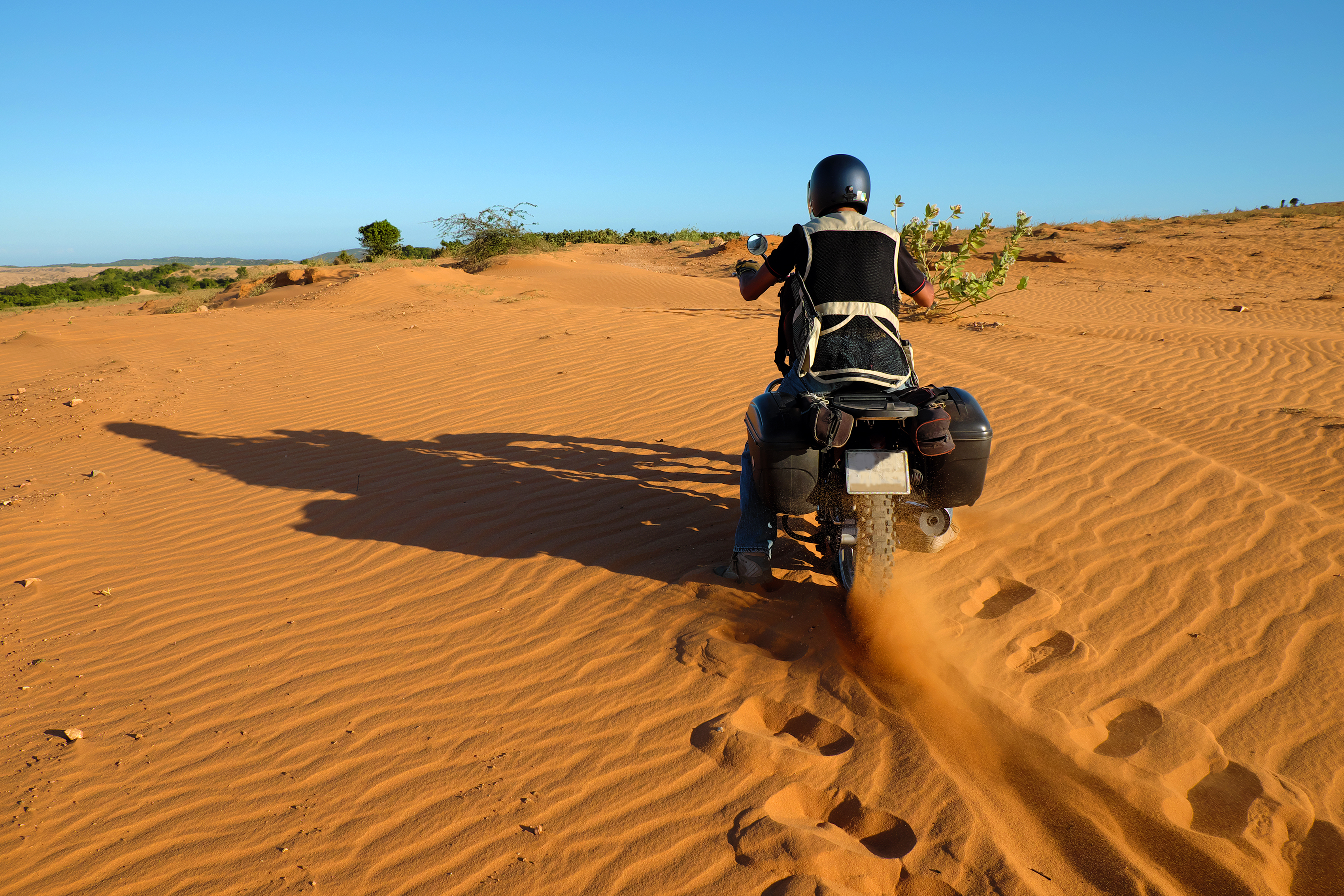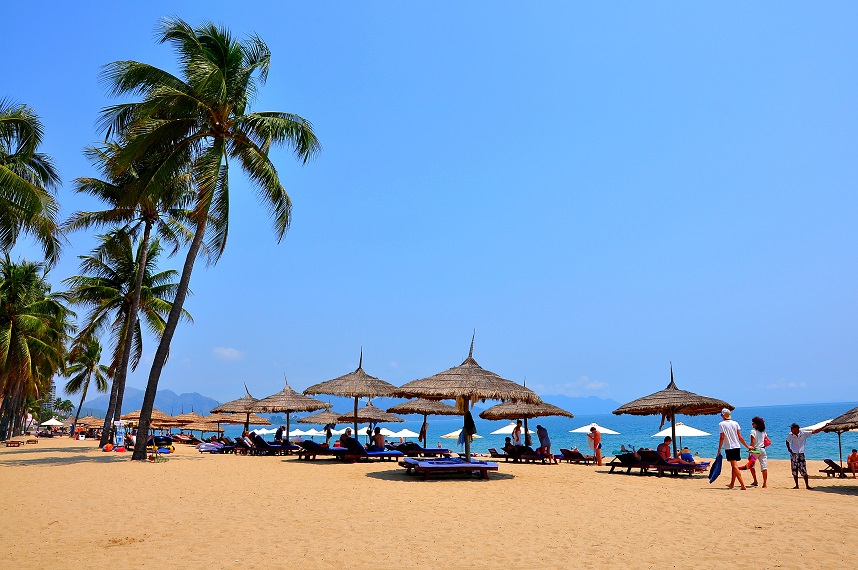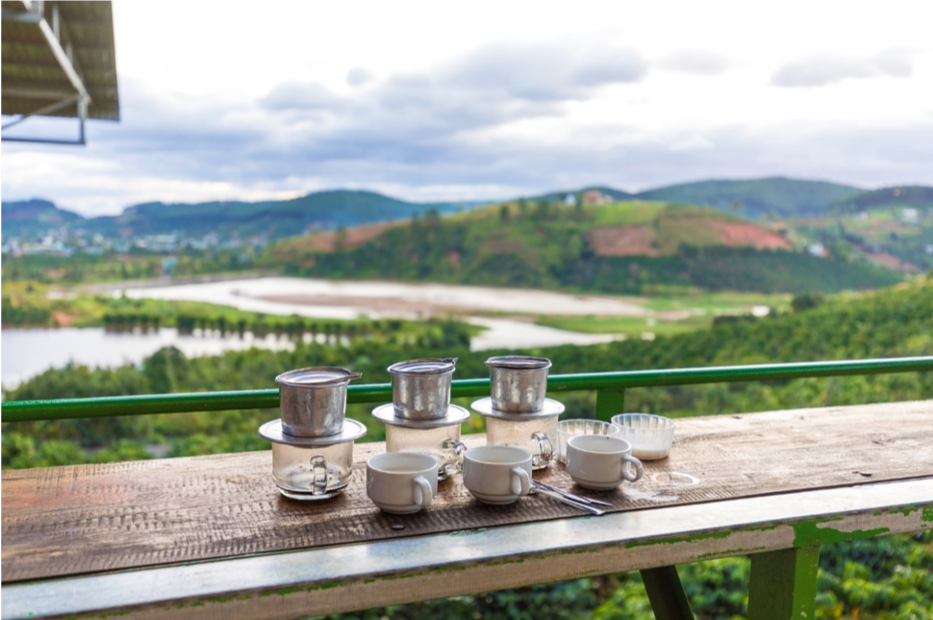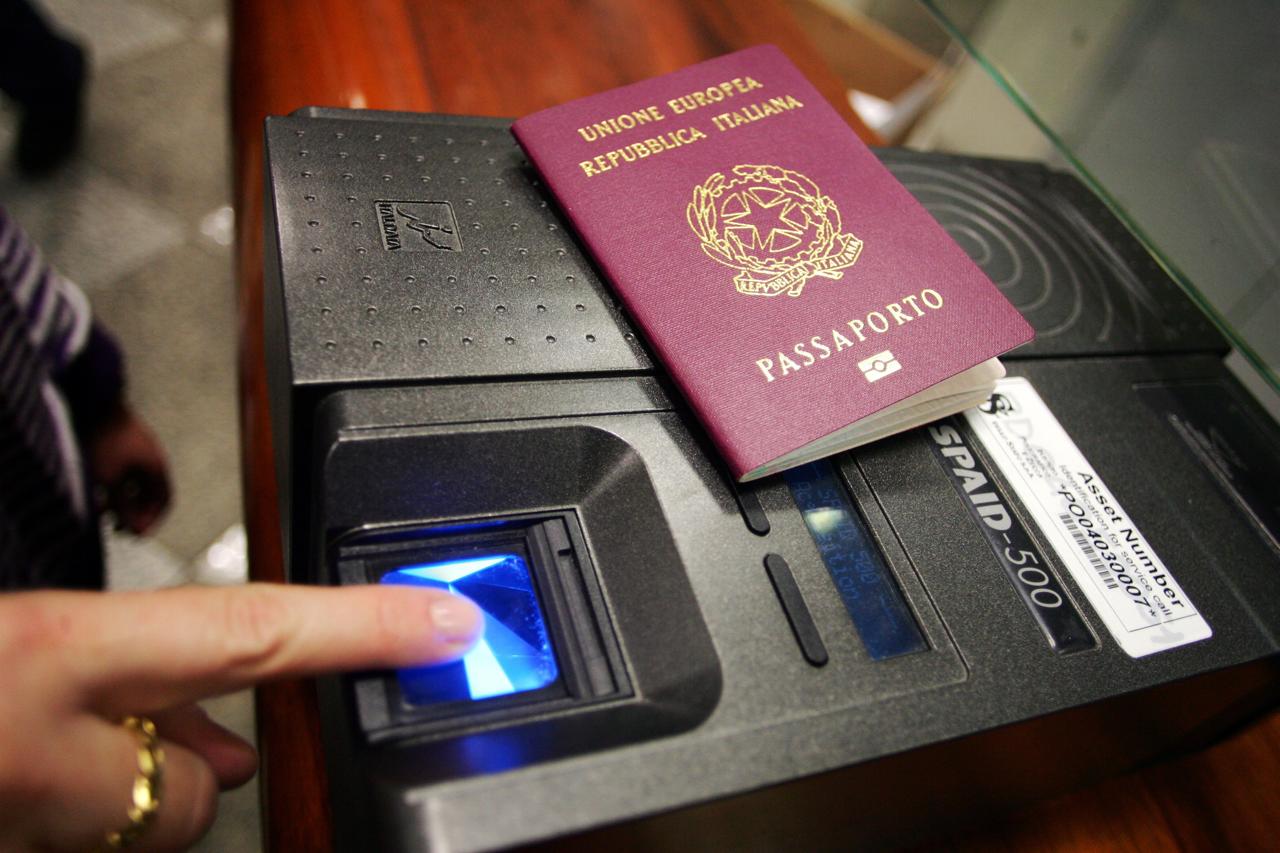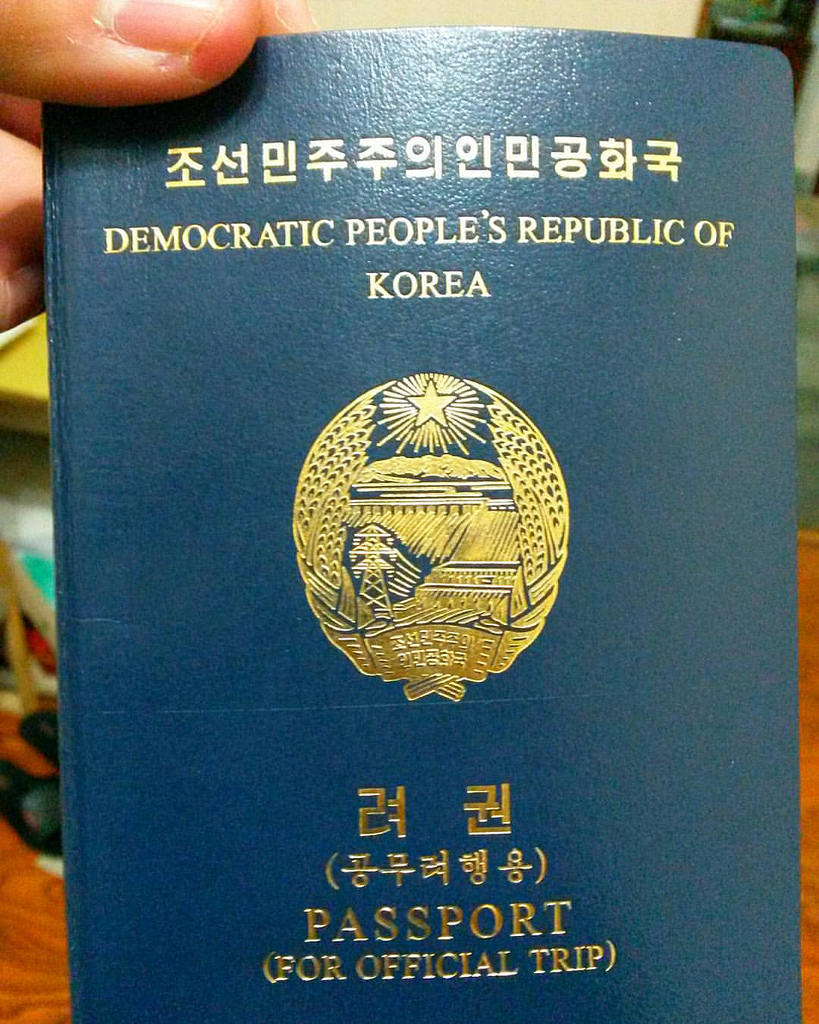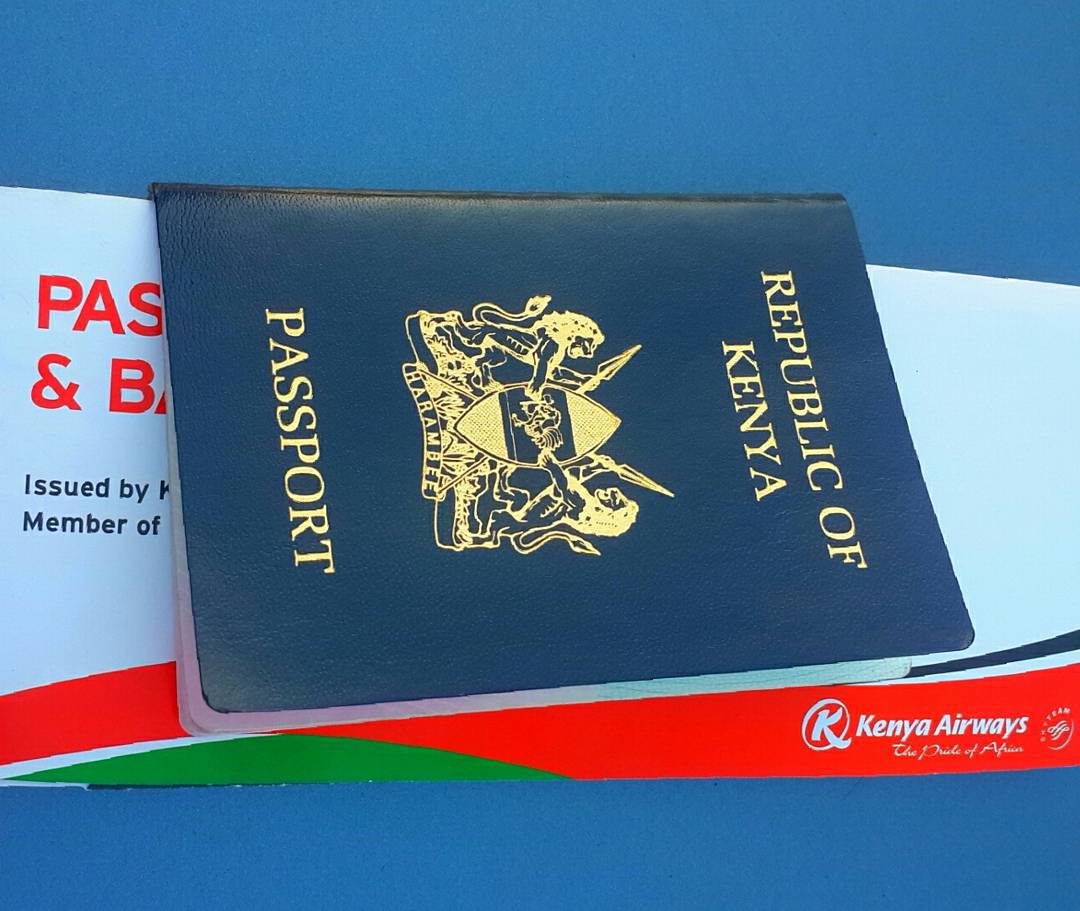Vietnam is a great country to visit. A country where the opportunity to find fun and adventure is only limited by your imagination. A geographically long and slender country where you travel mainly south to north or north to south. Every place you visit is full of great things to do and wondrous things to see. You will truly be amazed—every day is a new adventure!
You can take as much or as little time to plan your basic trip as you feel you need to take. There’s a ton of information on the Internet available for a person to study. Where in Vietnam do you wish to visit? How long can you take off to travel? Will you visit only Vietnam or will you visit other countries as well. Once you’ve set a date and chosen your destination airport you will buy your tickets and prepare to leave.
Arranging your visa-on-arrival
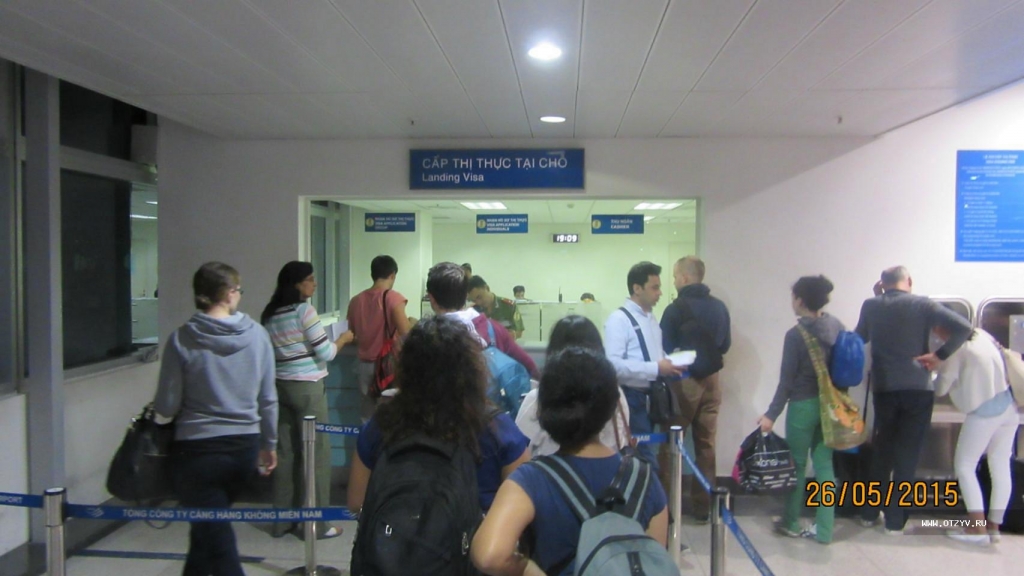
Vietnam landing visa in Tan Son Nhat Airport, Ho Chi Minh city
The last thing you must do once you’ve made your flight reservation is to go on line to Evisa-Vietnam.com and arrange for your Vietnam visa-on-arrival. Just fill-in the visa application and pay the visa fees either with your credit/debit card or with PayPal.
Evisa-vietnam.com then will email you an online approval letter which you print-out and pack in your bag in order to bring it with you to Vietnam. Just submit your copy of your approval letter at the airport to Vietnamese immigration along with your passport when you arrive at the immigration desk. Then pay the visa stamp fee in American dollars and they will stamp your passport and send you on your way. It’s as easy as that and now your Vietnam adventure can begin.
Going full length Vietnam On a Motorbike
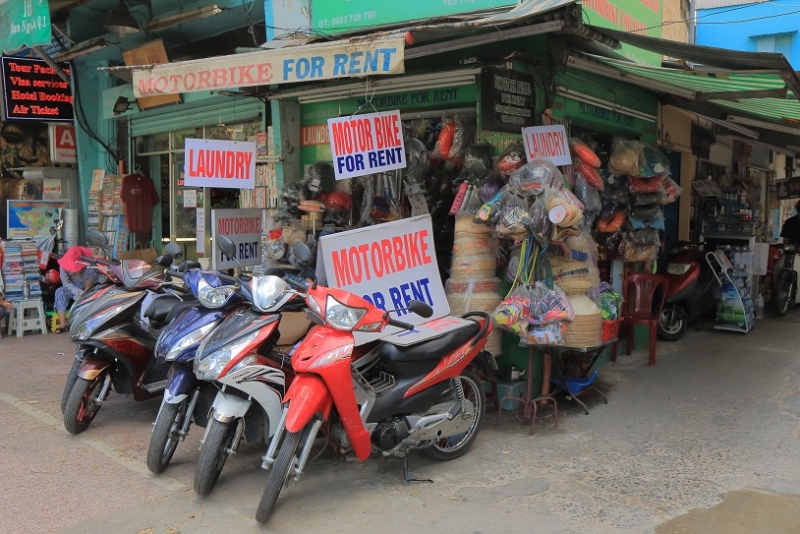
Motorbike rental in Ho Chi Minh City
One great way to see Vietnam is on a motorbike. (Bring an international driver’s license which you can get in the U.S. at the Auto Club or get a Vietnamese driver’s license in HCMC which will take about a week). Or If you’re a novice to motor biking than buy a scooter which is easier to drive and will work just fine and be safer for the inexperienced rider.
This plan is for the truly adventuresome person who wants to maximize their Vietnamese experience, is willing to be more flexible, and wants to have more fun.
The first thing you need to do is to buy a used motorbike or scooter (for less than $300) in HCMC which you will resell in Hanoi. Once you’ve made this purchase your ready to begin your great adventure. You are going to see and enjoy sights and scenery everywhere you go in Vietnam that are as good as anywhere in Southeast Asia. Once you and your motorbike are outside of Ho Chi Minh City, you are free to travel wherever you desire. This mode of travel allows you to move on your own schedule at your own pace and go and do exactly what and where you want.
But first here are:
Eight things you should know before you start your motorbike trip through Vietnam.
1. It’s super easy to buy a motorbike in HCMC so don’t hold back.
2. Make sure you can prove that you own it. A legal lamented registration card goes with every bike.
3. In Vietnam there’s really only two choices of bikes.
—- a. A manual 110 Honda Win motorbike and
—- b. An automatic scooter
4. Be good with maps and have a GPS on your phone.
5. Have a strong backpack rack on your bike.
6. Buy a rain coat cause it’s going to rain.
7. Always wear a helmet.
8. Buy a good travel insurance policy.
So here we go : Ho Chi Minh – Da Lat – Nha Trang
“Good Morning Vietnam.” You are on your way, bye bye HCMC. This country has it all. From jungles to beaches to mountains to more noodle soup and pho than you can ever eat. Experiencing all this from the seat of a motor bike over the next few weeks is going to be an incredible, once in a life time adventure I will never forget.
First stop, about 4 hours down the road is the beach city of Mui Ne. This is where you’re going to find the only desert in all of Southeast Asia. A place where you will see the novel beauty of the red and white sand dunes and even have a chance to surf down their face on a slick steel sled, if you like. And a place where, if you choose, you can windsurf some of the best surfing conditions, during the season, found anywhere on the planet.
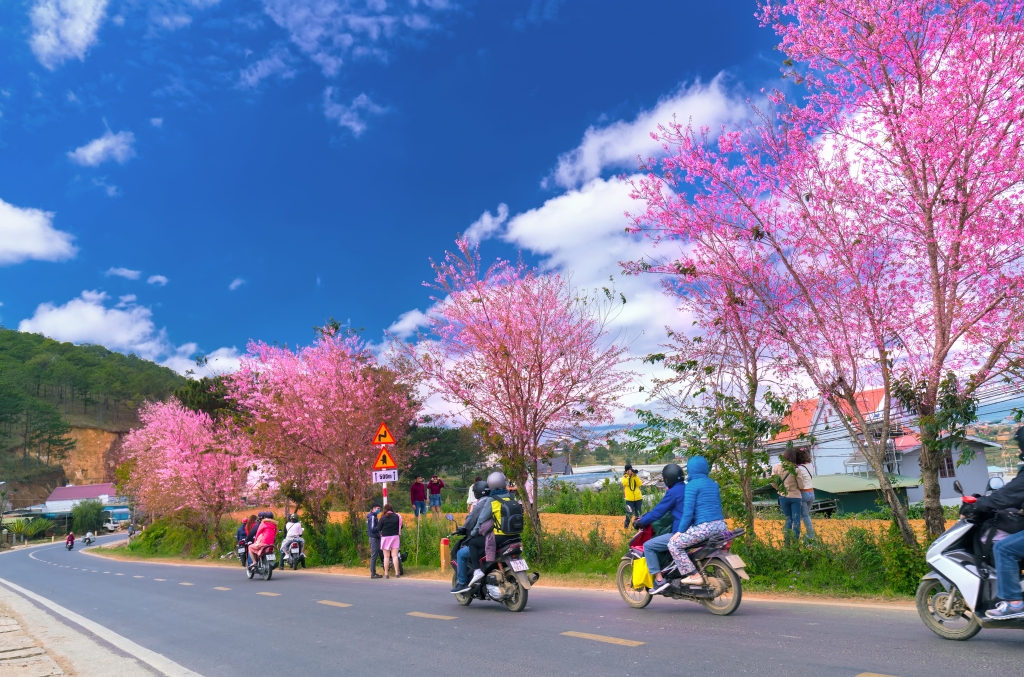
Spring coming in Da Lat
After Mui Ne we turned inland and headed up into the mountains on our way to the the city of Da Lat. This is a favorite, cool air holiday destination of tourists and the moneyed citizens of HCMC. Located 1500m above sea level, this European like city of 350,000 residents, consistently enjoys a spring like climate which is cool and refreshing therefore the nickname “city of eternal spring.”
This is not only a beautiful area and city but is surrounded by several natural attractions such as a large man-made lake and spectacular waterfalls such as one called “Elephant Falls” along with endless miles of picturesque countryside featuring both farmlands and wooded forest.
We spent our two free nights here in at the Dalat Green Hostel based on a locals recommendation which proved to be correct. The hospitality, warm atmosphere and incredible home cooked meals made this place an amazing steal at only $5 a night for a comfortable bed and a hot shower.
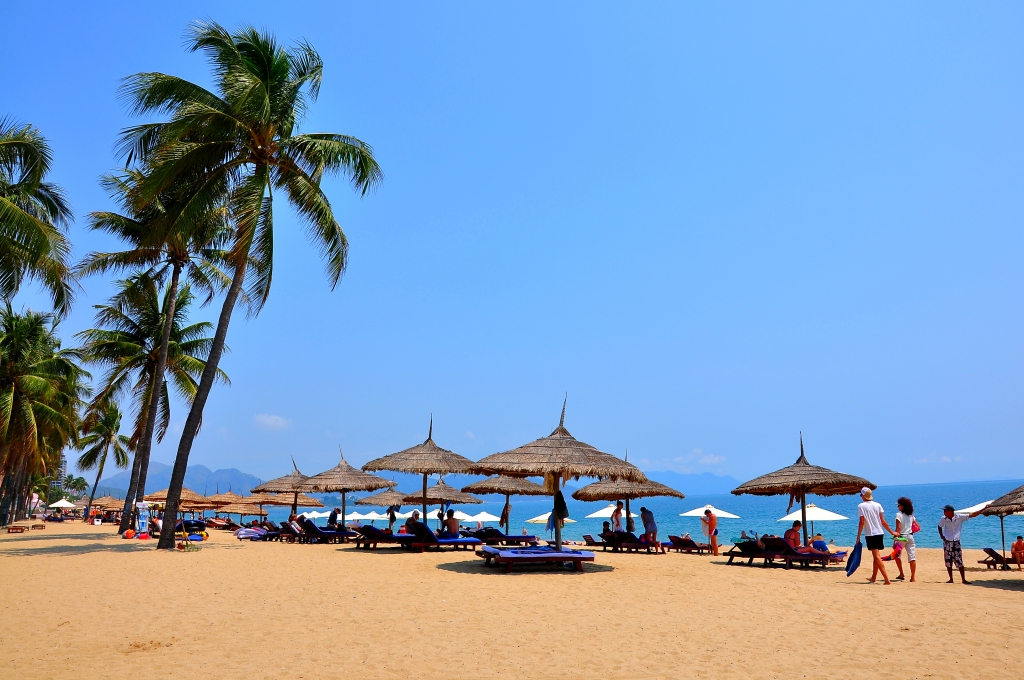
Nha Trang beach city, Vietnam
After 8 hours of winding down through the mountains we arrived in the most popular sea side holiday destination in Vietnam, Nha Trang. There is a lot to do in the city of Nha Trang if you like me, love the ocean, sun and parties— which of course we all do. So we were here in “heaven” for three fun filled days and nights enjoying this fun filled town. The clean and basic Le Thinh Guest House was a perfect spot for us and our our low budget to stay at only $13 per night. And located only 200 meters down the beach from the extremely popular Sailing Club night club we had a perfect location for our night time prowling.
Through the Central Highlands of Vietnam
There’s something sexy about seeing Vietnam from the seat of a motorbike or scooter. If you’re determined, you can accomplish this feat regardless of your level of experience. If your patient, take it slowly, and go one step at a time, you will be successful and have the best experience of your life in the process.
Riding north up through the mountains of the Central Highlands was a beautiful and rewarding experience. Cooler than the AH1 coastal route it provided a welcomed relief from the hot and humid air of the coast and southern part of Vietnam.
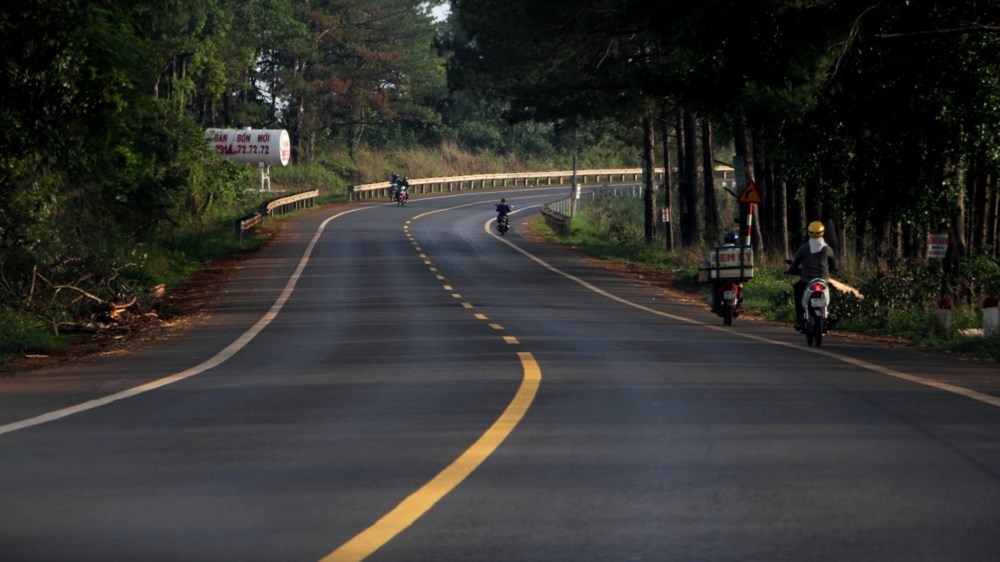
National Highway 14 heading to Kon Tum city
Going through the Central Highlands is a route that is well off the beaten coastal path. Bikers like it because it’s safer than the coastal route in that there are much fewer trucks to contend with along the way. On the negative side we did not encounter many English speaking natives, so communicating with the locals was much more difficult. However the scenery makes up for this small inconvenience. It’s amazing just how inspiring we found this stunningly verdant landscape to be. Every day we encountered something new and inspiring.
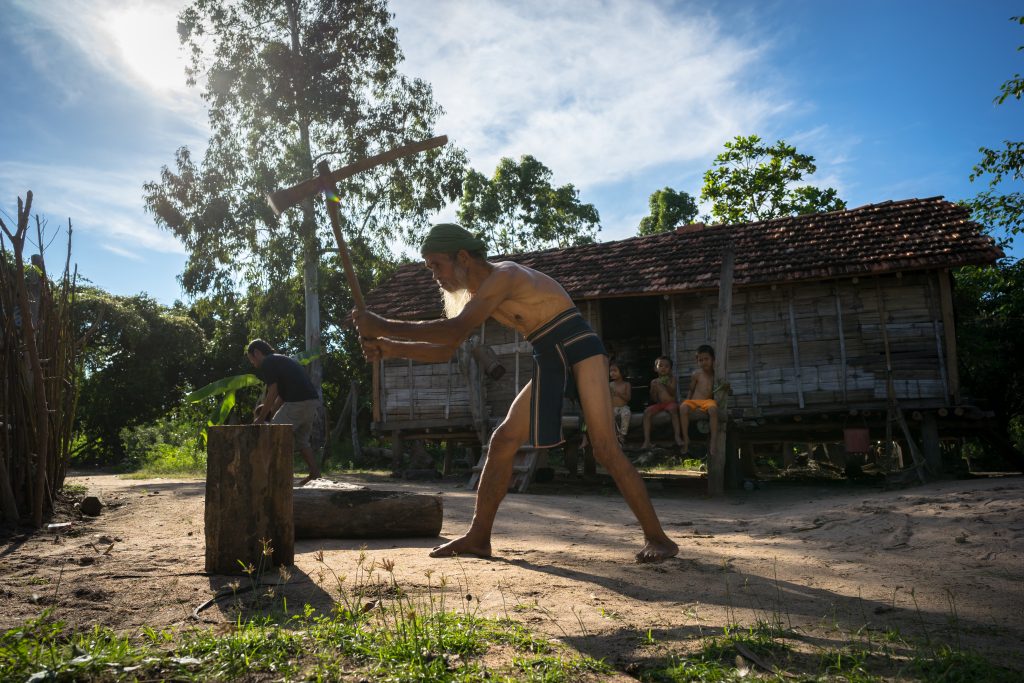
A view of a village in Central Highlands of Vietnam
While the local population is relatively small the Central Highlands is strategically important as it borders both Cambodia and Laos to the West. This is the primary reason why this region experienced so much heavy fighting during the American/Vietnam war around the cities of Buon Ma Thuot, Pleiku and Kon Tum. All three are cities which we traveled through on our way to the coastal city of Hoi An.
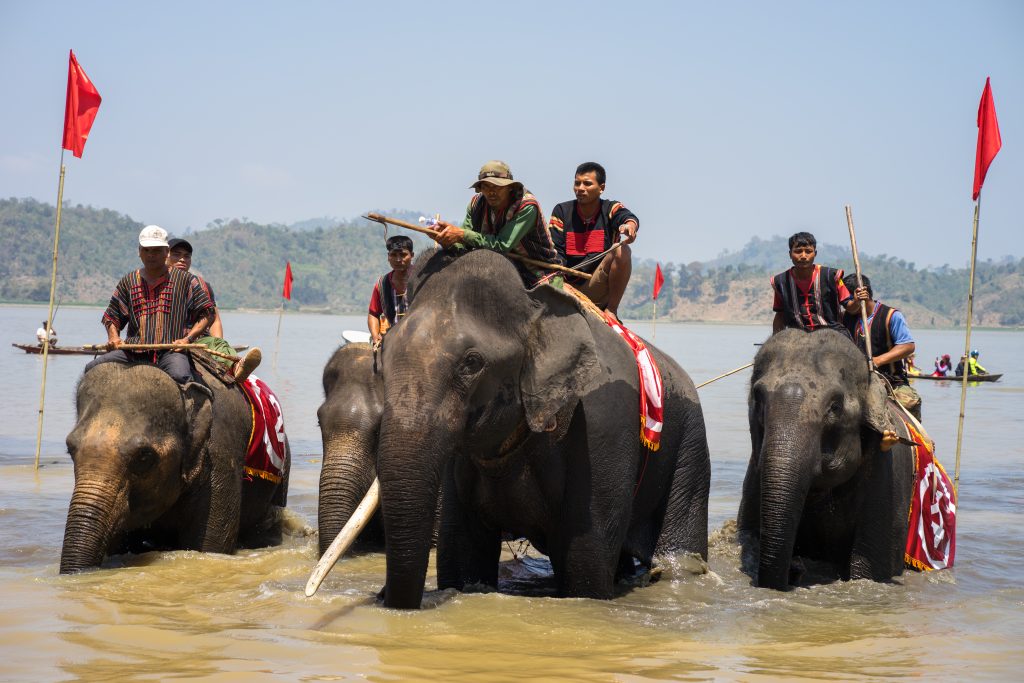
A view of an elephant racing festival by Lak lake in Dak Lak, central highland of Vietnam
We found this region to be appealing not only because of the beautiful landscapes and the pleasant cool climate but also because of the mist-laden mountain scenery complete with plentiful lakes and waterfalls. In addition the local minority tribes, collectively named Montagnards by the French in the 1800’s, are a wonderful people whose friendly demeanor make the travel in this area all the more pleasant. Due to the impact of the war, this region was not opened to foreigners for travel until about ten years ago.
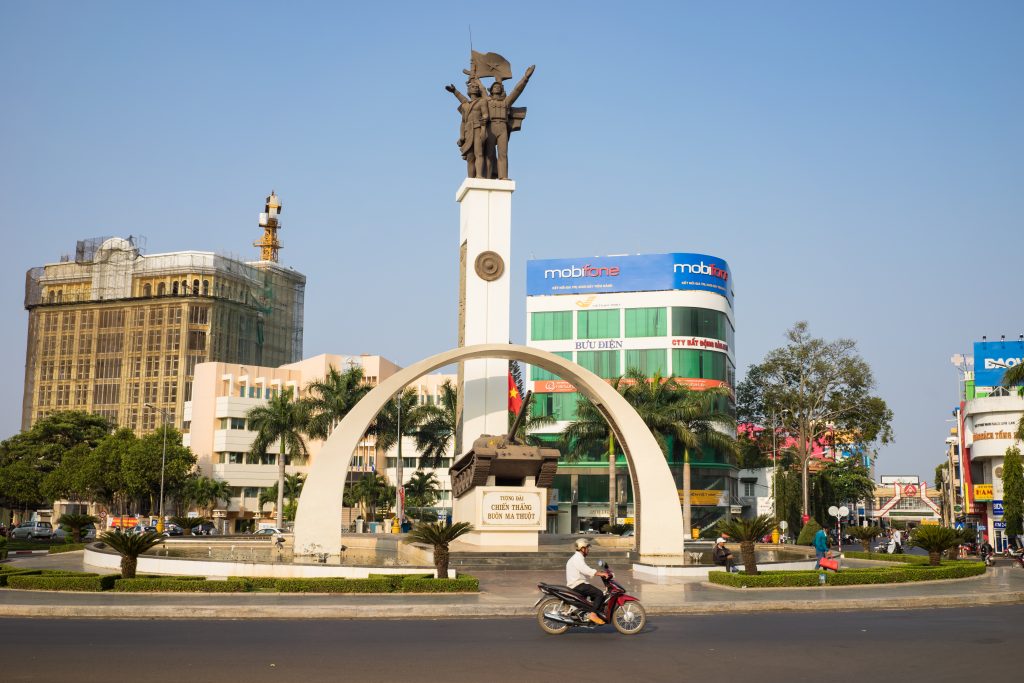
Victory monument of a T-54 Tank in central point of Buon Ma Thuot city
The small city of Buon Ma Thuot, 190kms from Nha Trang was our next overnight stop. Similar to Da Lat in size and climate, it is much less touristy. Famous for being the home of Buon Ma Thuot Coffee, a popular brand of Vietnamese coffee, sold all over Vietnam in coffee shops, small stores and super markets.
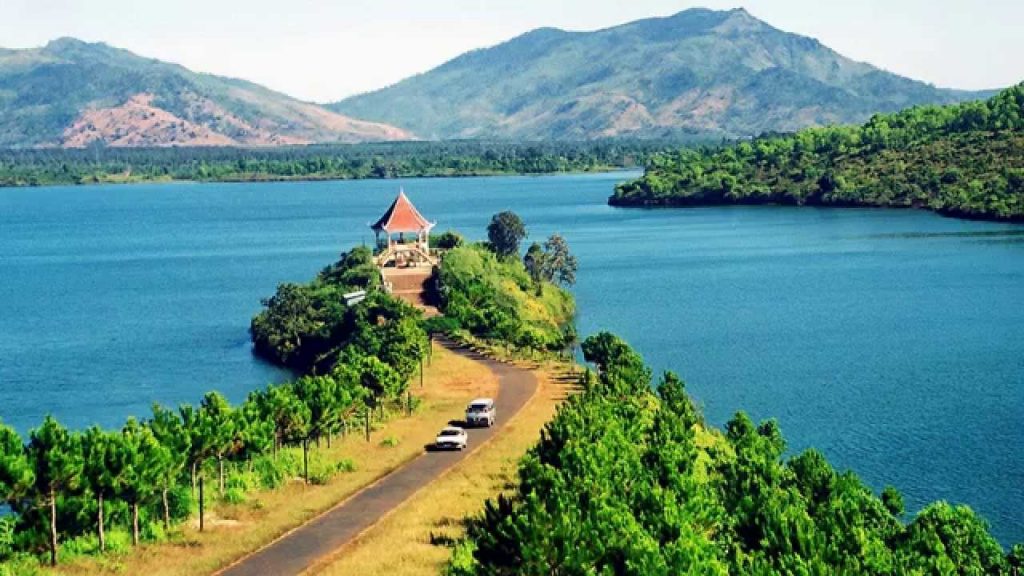
A view Bien Ho Crater in Pleiku
We typically tried to travel between 150km and 200km per day so our next stop at the small city of Pleiku, which at 180km down the road, was perfect. The scene of deadly military battles during the war, for us it was just a peaceful place to rest in a home stay with a local family for the night on our way to the coastal city of Hoi An. The next morning, 8km outside of Pleiku we briefly made an memorable short detour at a scenic spot, the volcanic, water filled Bien Ho Crater.
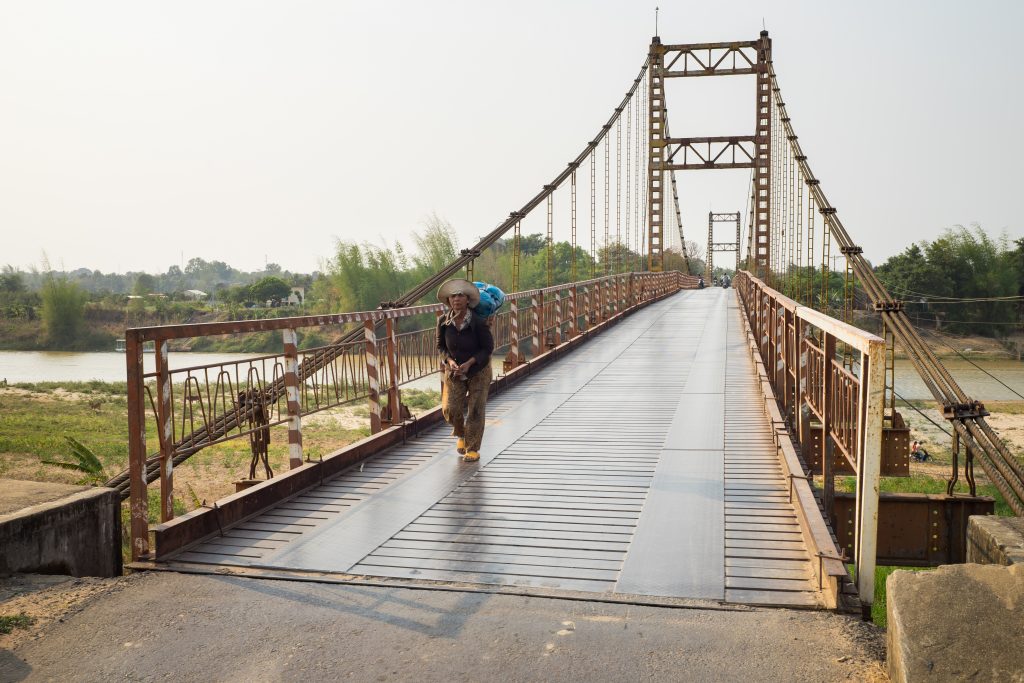
Kon Klor Suspension Bridge, road to famous Kon Kotu old village in Kon Tum
Our next rest stop was at the rural city of Kon Tum. Home to several ethnic hill tribes, it is one of the poorest areas in Vietnam. Here is found the traditional “tall houses” in which they both live and work. This stop, more than any others, opened our eyes to a real part of the poverty of Vietnam’s rural culture.
After an extra long day of riding, at 280kms, we finally reached the ancient trading city of Hoi An. Here we spent three entertaining and fun filled nights at the famous “party central,” Sunflower Hostel, the backpacker’s favorite stop over.
Hoi An is a beautifully well preserved UNESCO World Heritage site which is extremely popular with tourist from all over the world. (If I’m being honest maybe just a little to popular). Famous for being the home of the colorful hanging lanterns of Vietnam, this place is a romantic wonderland at night, especially along the river with the lanterns and the little floating candle boats sold by the locals on the bridge. We totally enjoyed our rest from bring on the road while spending the time sunning poolside at The Sun Flower Hostel and on the beautiful sand at near by An Bang Beach. We bought some customized screen printed T shirts as souvenirs at the local clothing shop. And we loved walking through the ancient streets and along the riverfront in this quaint ancient city on our way out to dinner or lunch. One real highlight was taking a fabulous 3 hour Vietnamese cooking class one afternoon at a trendy local restaurant.
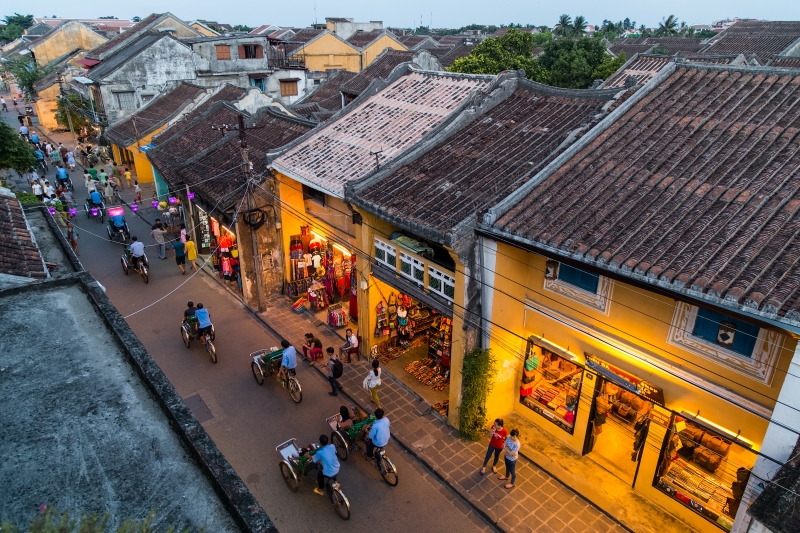
People walking on the streets of old town Hoi An, Vietnam
11 Life Saving Tips For Driving Motorbikes in Vietnam
- Avoid Busses— In the Front and In the Back.
- Always Check your kickstand making sure it’s up every time you start your bike.
- Only use the back brake.
- Go with the flow—of traffic that is.
- Bring “coffee money” for bribing the police.
- Have Travel/Health Insurance.
- Stay cool on the road. Road rage is a bad idea.
- Do not drive at night—EVER!
- Buy a GOOD HELMET—it might save your life.
- Turn Left in a Group, not against the traffic.
- Look Both Ways at Every Intersection.
Traveling North to Hue
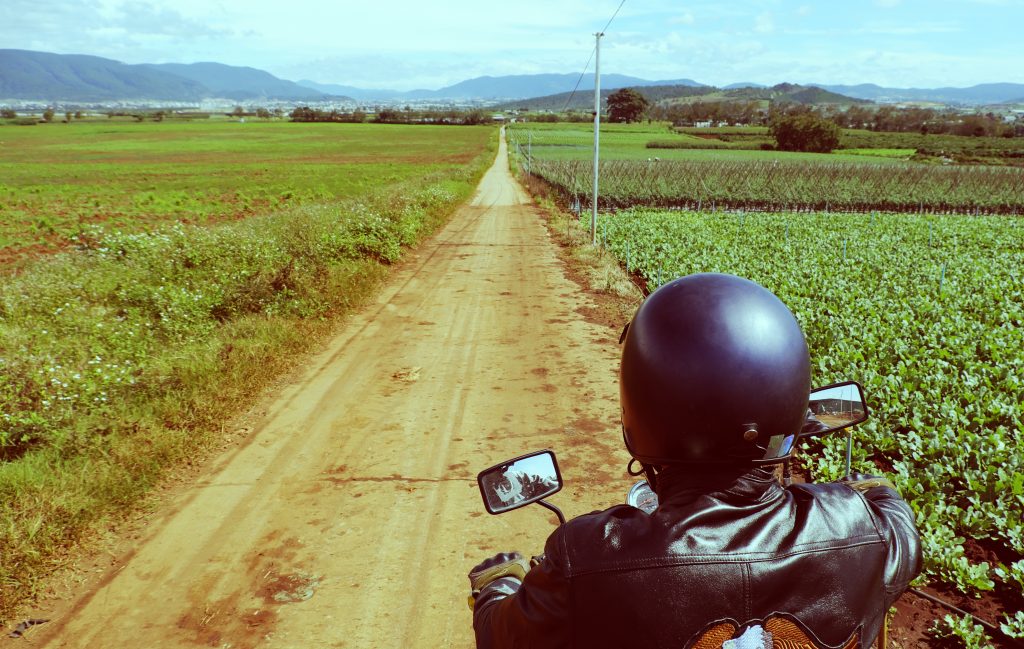
Riding motorbike on Vietnamese countryside road
The next day we left the Sun Flower Hostel early, after eating a filling breakfast, on our way to our next stop in the ancient city of Hue, 165kms North of Hoi An. We rode along the coast until we passed over the Han River on the colorful Dragon Bridge as we entered the large seaside city of Danang.
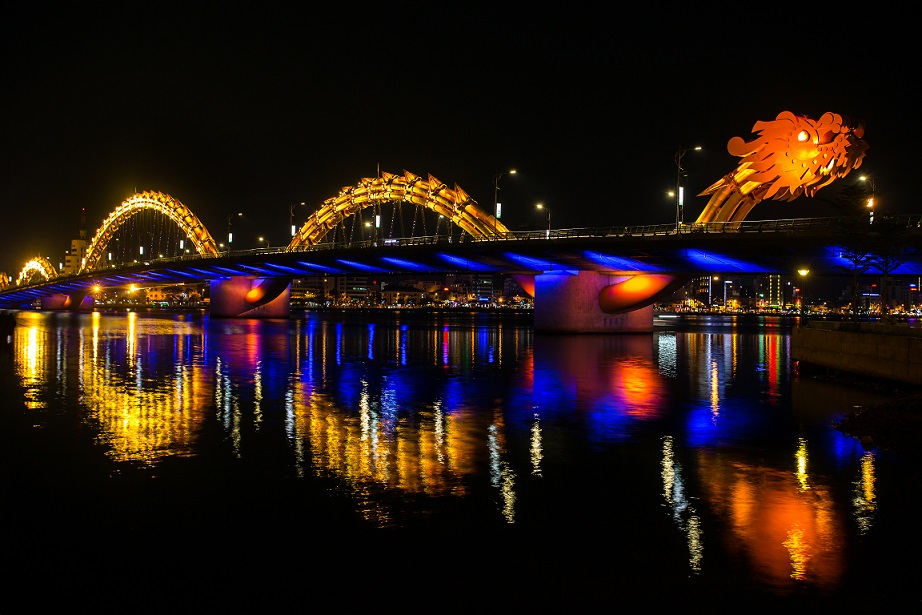
Dragon River Bridge (Rong Bridge) in Da Nang, Vietnam
Before long we were heading up the steep mountain road on the famous 21km long Hai Van Pass. The 1500m pass is the “climatic divider” between North and South Vietnam. Between November and April, on any given day it can be cold and rainy on the northern side and clear and hot in Danang city to the south.
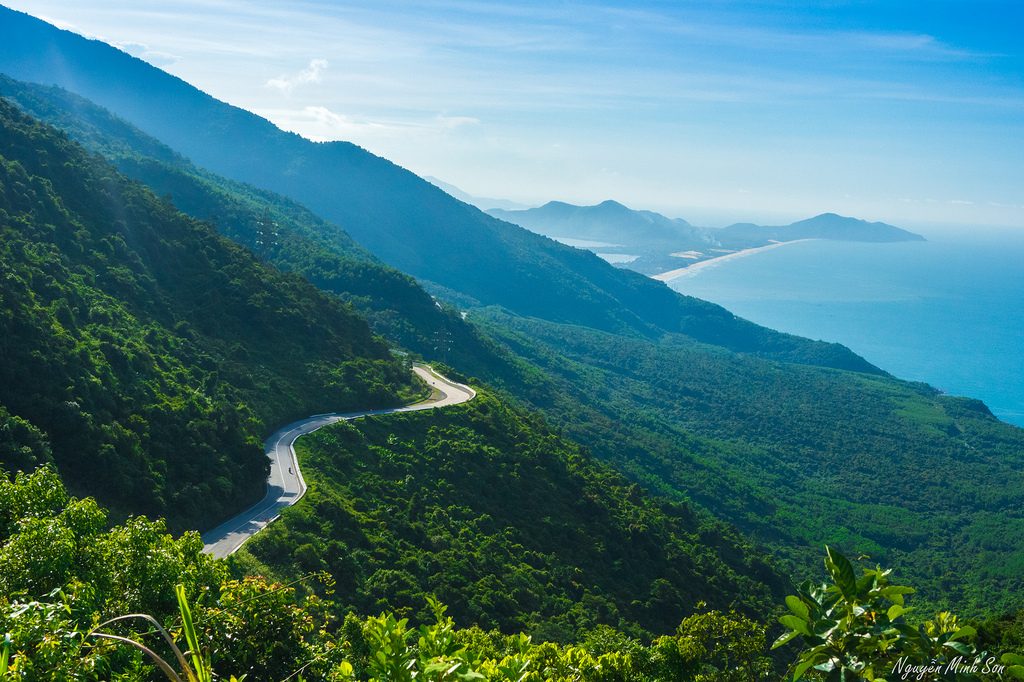
Hai Van Pass
The pass was once the only coastal way over the Truong Son Mountain Range until 2014 when the 21km-long Hai Van Tunnel, cutting a major detour around most of the pass was finally completed after 5 years of difficult construction, drilling a giant hole in the side of the mountain. Now all traffic except for oil tankers, motorbikes and sight seers goes through this, the longest tunnel in all of Southeast Asia. The tunnel has really reduced the time to travel to Hue as well as significantly reducing the pass’s traffic, making the ride over the pass a most pleasant experience for us.
The Hai Van Pass is the location of the ancient Tran Dynasty Hai Van Gate, war time gun towers, and a decrepit old French built fort that was used as a bunker by the South Vietnamese and American Army during the American War.
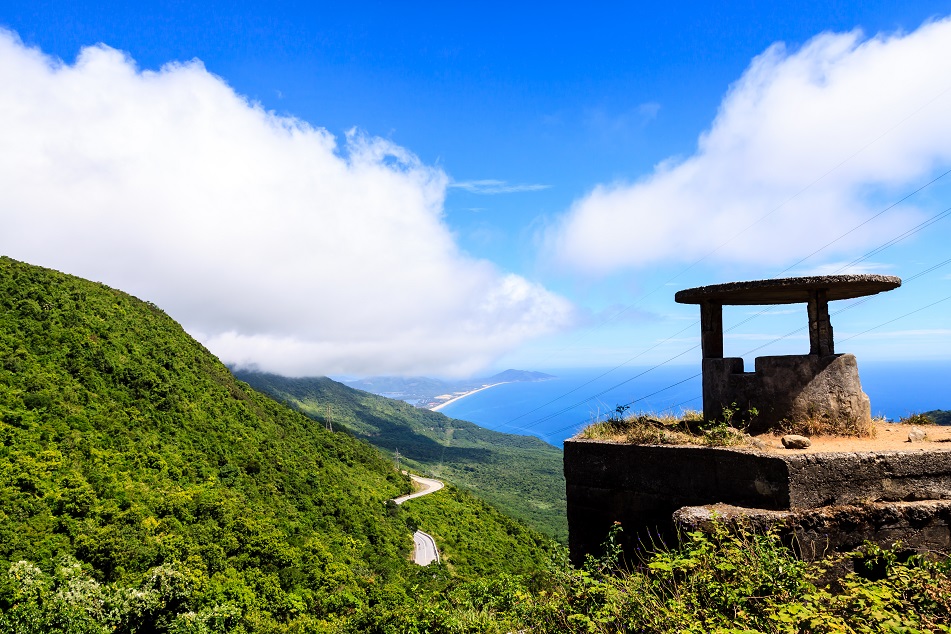
War time gun tower on crest of the Hai Van Pass
Before the time saving Hai Van tunnel was completed the pass was notorious for fatal accidents as we could see by the many small alters along the road that are dedicated to the unfortunate victims of these crashes. Now the rare fatalities are a result of the “Danang locals” thrill seeking motorcyclists racing up and down the sparsely traveled pass testing themselves against the many hairpin turns.
Since we took our time, our journey to Hue lasted over 5 hours. We ventured off on a couple of side roads for better viewing of the East Vietnam Sea including a stop on the seaside to enjoy a delicious fresh fish lunch. The weather was great as we were traveling in August, so there was no fog or rain, but it was a warm 18 degrees at the lower elevations which we actually enjoyed.
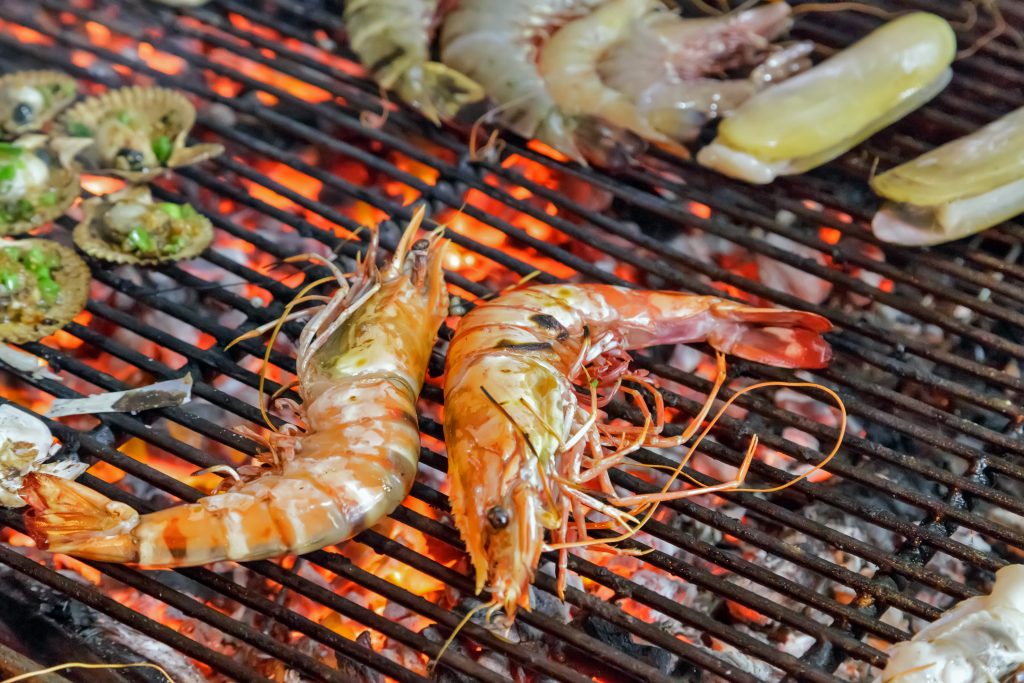
Remember to enjoy for fresh seafood
The Hai Van Pass was a perfect route for us to take as it allowed us to avoid the shorter but much busier and more dangerous Highway 1. The beautiful blue sky and white fluffy clouds was a marvelous backdrop for the sparkling ocean below. If you’re not in a rush and have the time there are several interesting side trips and loops you can take along the way, two of which we took.
We finally reached Hue about dark and decided to indulge a little luxury by splurging at at the highly regarded 3-star, Scarlett Boutique Hotel located right in the middle of the city’s prime location. The hotel upgraded our stay to the Scarlett Suite which is a beautiful room that included breakfast, free parking and a balcony, with a special price of only $38 per night. We both noticed how friendly and accommodating the entire hotel staff was towards us during our visit which really made our experience all the more special.
After some much needed rest we ate some excellent Vietnamese food at a local street restaurant and then celebrated Friday night with drinks and dancing at the highly recommended Brown Eyes Bar located close to the hotel. This turned out to be a good choice and we had a great time on our first night in Hue.
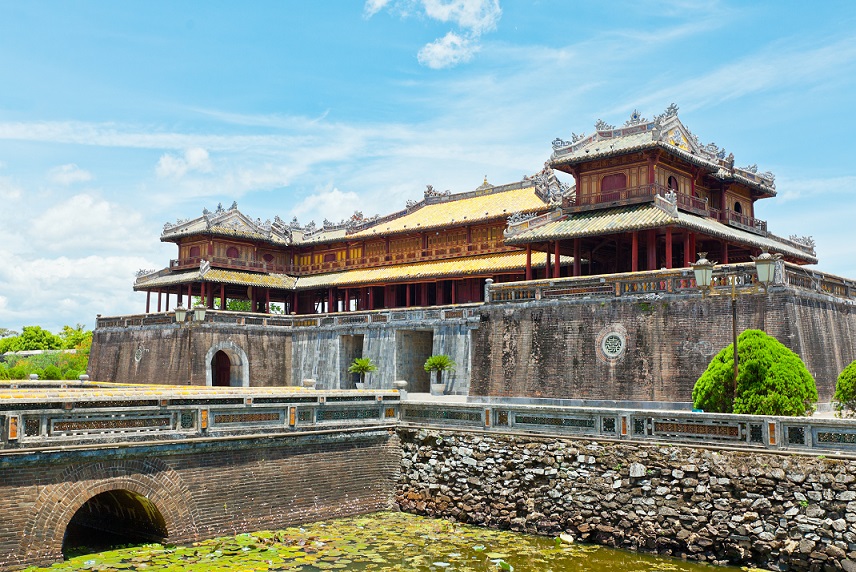
Noon gate of Hue Citadel on the Northern bank of the Perfume River. Hue city
The next morning, we enjoyed a super breakfast buffet and then headed out of the hotel to explore the capital of the nearby ancient city, The Citadel—the former imperial capital of Vietnam. Located on the northern bank of the perfume river it is a huge location that took us a couple of hours to explore.
From 1802 until 1947 the Citadel was home to several generations of the Nguyen Dynasties. The Citadel itself is square in shape and surrounded by a moat and wall which is six meters high and two and a half kilometers long. There are ten large gates that serve as different ways to enter and leave the Citadel— its most prominent feature being a tall flag tower which is the most photographed structure on the property. The most impressive gate remains the Ngo Mon Gate which once served as the exclusive entrance for members of the royal families and their eunuch servants.
We found the overall site to be stunning due in part to the ornate architecture and incredible and well kept landscaping of these expansive grounds. The Citadel served as home to the royal families from 1802-1945 when the rise of communism put an end to all dynasties. The Imperial City is located in the center of the Citadel behind the Throne Palace and was known as the “Forbidden Purple Citadel” which was reserved for the emperors and their families.
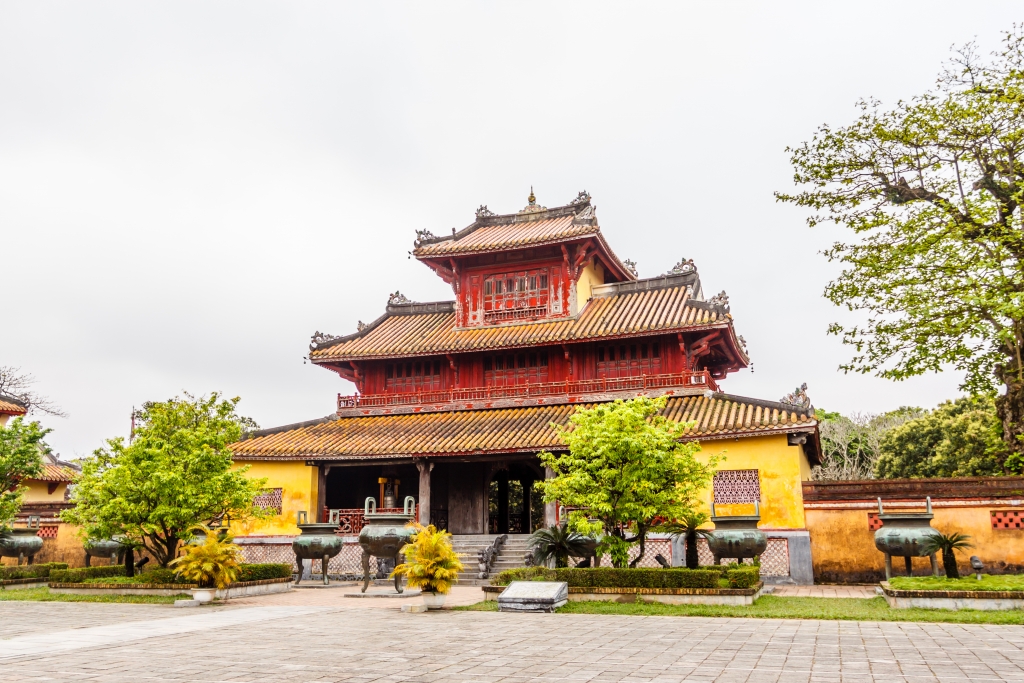
The Forbidden Citadel in Hue city
Unfortunately, the Citadel was severely damaged during both the French War and the 1968 Tet Offensive battles during the American War.
Since our northern route would take us inland from Hue we would not have an opportunity to pass through the infamous DMZ on the 17th parallel. Not wanting to miss this iconic symbol of the American War we signed up for an all day tour, which we would take the next day.
Visiting the DMZ
The bus tour from Hue to the DMZ, we learned, included 12 hours on a hot crowded bus with little time actually spent on site. In addition we determined that we would be back tracking over 60km from the old Khe Sanh Marine Corps base back to Hue. So we decided to forego the bus tour and ride our motorbikes north to the city of Dong Ha and speak with Mr. Tinh at the “DMZ Café” about hiring a guide to show us the various attractions which we wanted to visit.
That way we would see the important sights of a historical DMZ and be on our way to the north when we finished visiting the old Marine Corps Base at Khe Sanh without wastefully duplicating our time and miles—as we had planned to take the route on the Ho Chi Minh Trail that passed through Khe Sanh anyway.
Mr. Tinh arranged for Mr. Tam, who had been a child during the war, to guide us to the Vinh Moc tunnels and then on to the “Rock Pile” and Khe Sanh the old Marine outpost base, for only $17. Mr. Tam’s knowledge and insights proved invaluable and markedly added to our understanding of what had transpired here decades before.
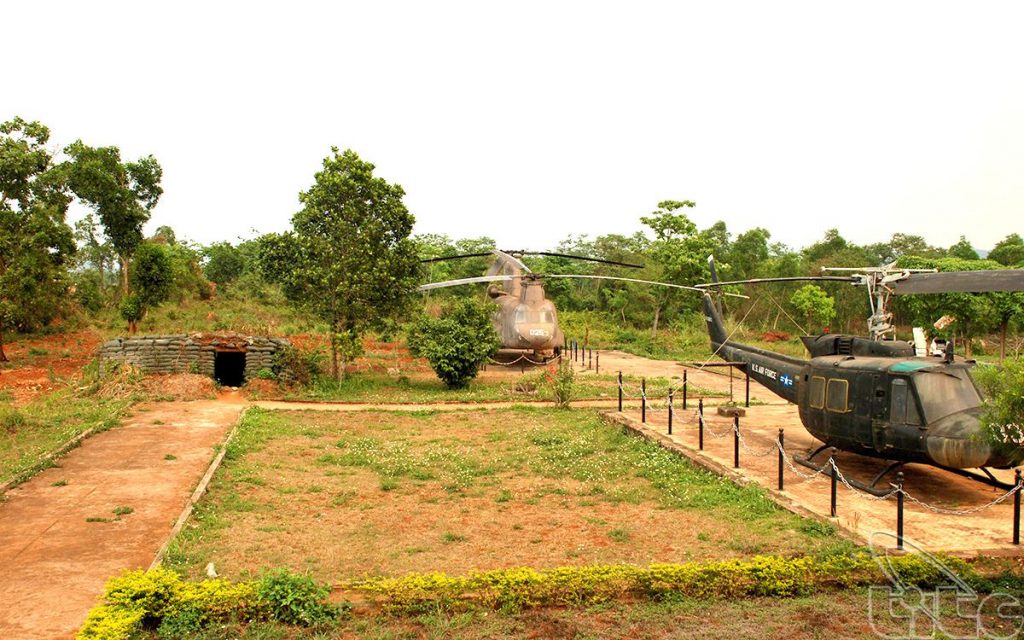
Marine Corps Base at Khe Sanh
Most of the allied outposts and bunkers of the Demilitarized Zone dating back to the war have long since vanished, the victims of jungle growth or non use. Once the scene of some of the bloodiest and most intense fighting of the war, the few remaining skeletal out posts serve as a distant reminder of the horrors that had occurred decades before. During the war The DMZ was primarily recognized by a line reaching out 5km on either side of the Ben Hai River and as a visible marker for the 17th parallel. Between 1954 and 1975 it served as the buffer zone between the North and the South becoming one of the most militarized areas in the world.
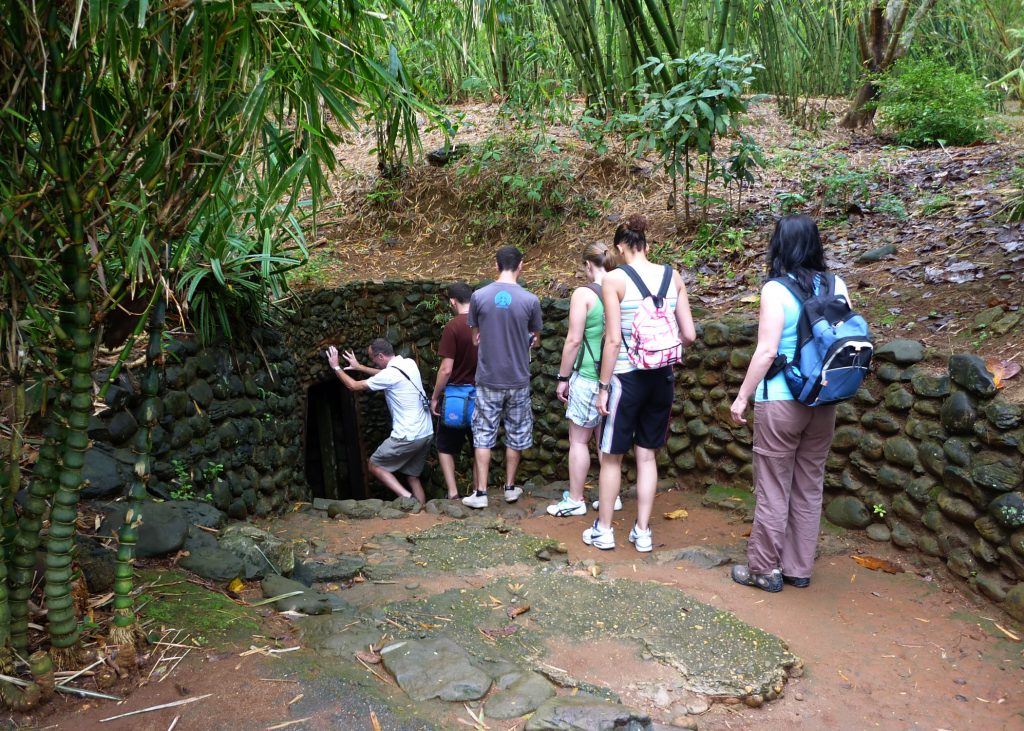
A view at the entrance of Vinh Moc Tunnels
We first visited the Vinh Moc Tunnels located just north of the Ben Hai River and 37km north of Dong Ha. This tunnel is just one example of the over 110 tunnels which had been originally built in this area of the DMZ. Vinh Moc was a large tunnel complex where around 300 people had lived in small compartments as families for over six years during the war. Unlike the tunnels in the south these tunnels were not used by soldiers but rather by civilians who were attempting to avoid the intense bombing by the American war planes. It was calculated that for every civilian living in these caves during those three years that, incredibly, over 7 tons of bombs per person had been dropped. A really huge waste of money and resources by the badly mis-informed Americans. To this day the DMZ remains one of the most intensely bombed areas anywhere on earth.
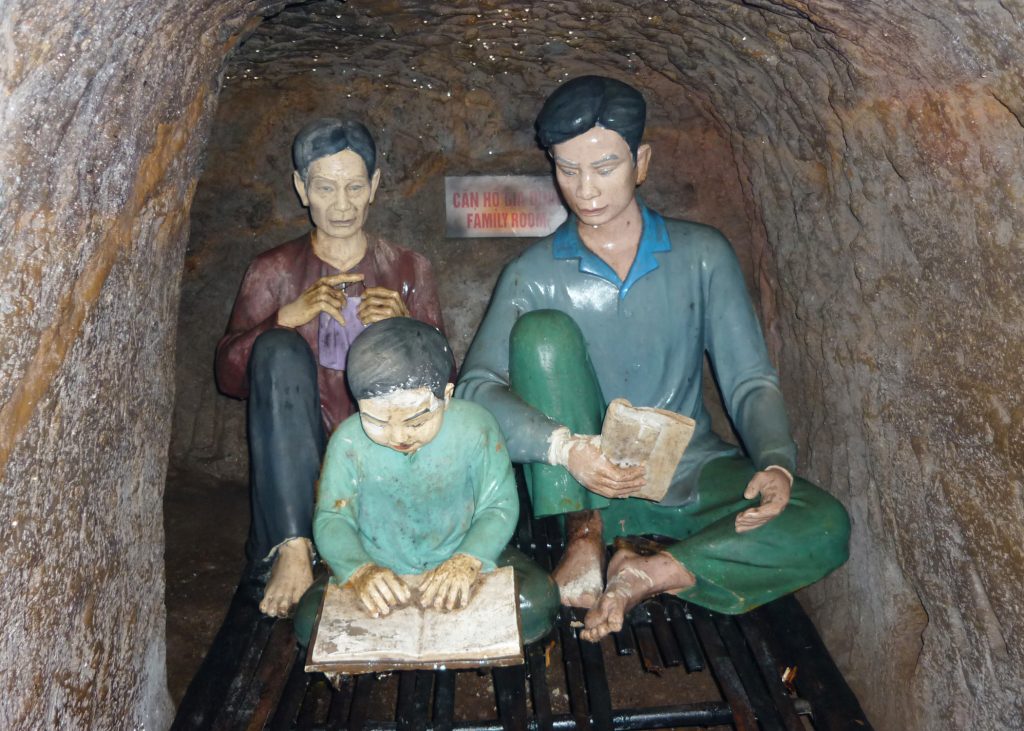
A room inside Vinh Moc Tunnels
Secretly built between 1966 and 1967, the villagers dispersed the soil at night so as to not be detected from the air by enemy surveillance. The tunnels were built on three separate levels with the the third level being 23 meters deep. When a new bombing run would start the people would hide in the tunnels for anywhere from a few hours to up to a few days at a time—the record length of time being an amazing uninterrupted 5 days and 5 nights without leaving the tunnels.
Our tour began by entering the tunnels through a nondescript hole in the ground as we moved down, down, down into the labyrinth of dark tunnels where we could see various nooks and small rooms used as sleeping quarters, kitchens, operating rooms, nurseries and even a maternity ward—17 babies were actually born in the tunnel, six of whom still live in the local village today.
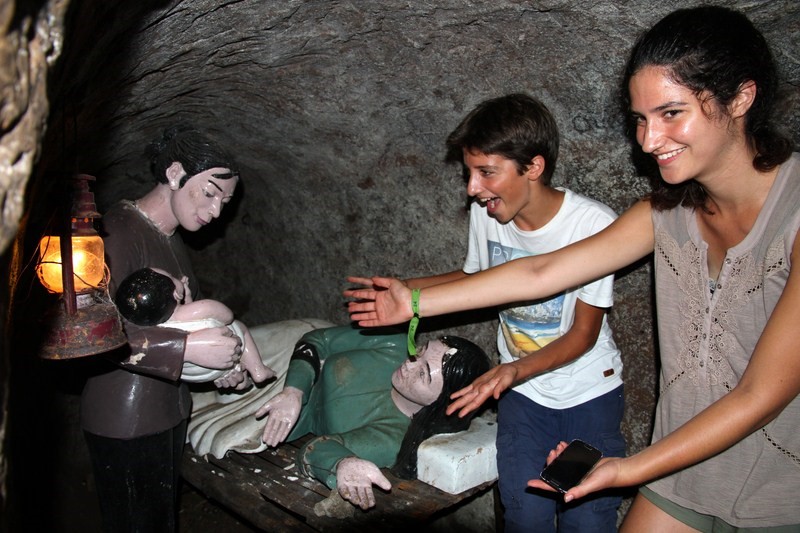
Maternity room in Vinh Moc Tunnels
The tunnels are very small, being only 1.5 meters tall and 1.2 meters wide, and dark. Accordingly we moved along slowly as we explored the cramped space which had been home to up to 300 people at a time during the war. Dioramas displaying replicas of people from that era are staged along the way adding a taste of realism to the tour. As it was just the three of us instead of a bus full of tourists our experience was exceedingly more pleasant as we moved through the tunnels there bye reinforcing our decision to come on our own without the tour.
The Vinh Moc Tunnels stands as an amazing achievement of human toil and engineering, built with no sophisticated tools, just picks and shovels as they had little else at their disposal but cunning and determination. These tunnels are actually a metaphor, representative of how a small beleaguered country like Vietnam could take on a military giant like the United States of America and win.
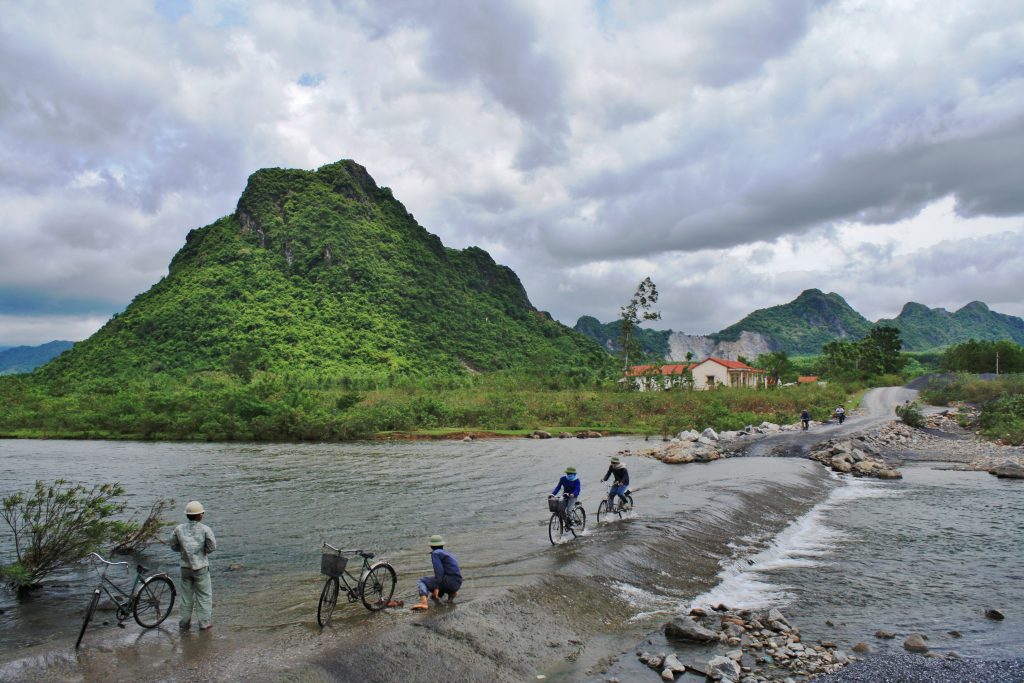
The Rock Pile, Khe Sanh
Our next stop was a hill once known as The Rock Pile. Now just a jungle covered hill sticking above the jungle floor, this out cropping had once served as an important observation post assessable only by helicopters. After taking a few photos we took a quick jog over to the infamous Marine Corps outpost base, Khe Sanh, located nearby on the Ho Chi Minh Trail.
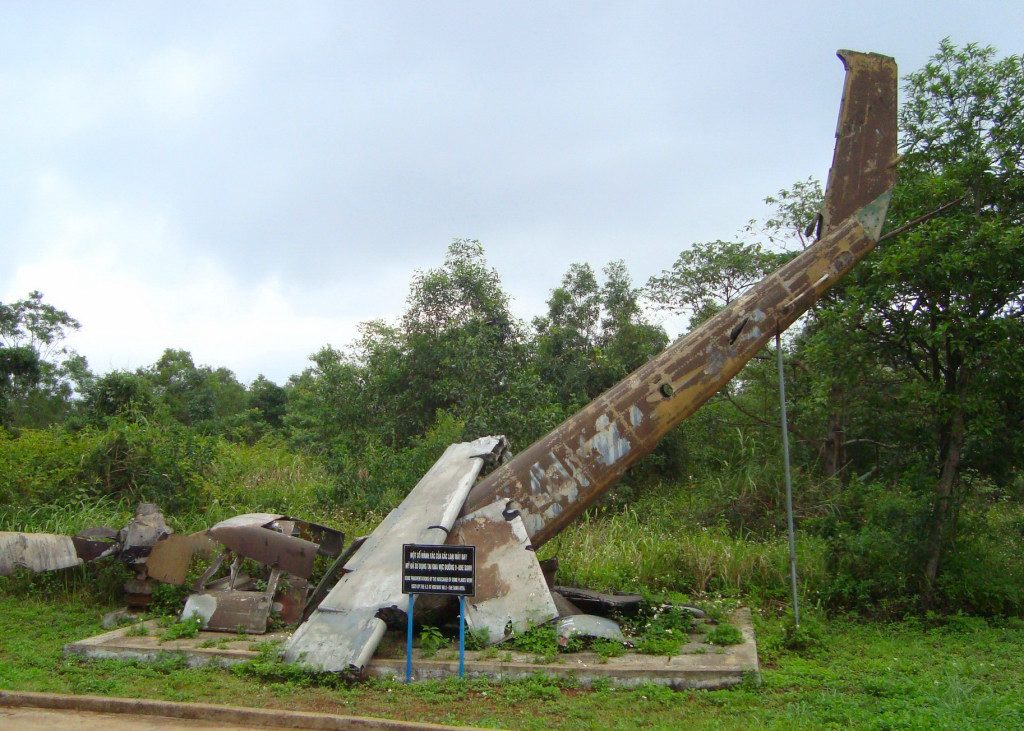
Helicopter and plane wreckage in Khe Sanh
The Khe Sanh Base had been the sight of extremely fierce fighting, including one unsuccessful and very bloody 77 day siege by the north on the Marine Base in 1968. All that is on display for visitors to see now are a couple of crashed helicopters, a damaged plane, a collection of artillery shells, a big gun and a small museum displaying photos and old artifacts from both north and south Vietnamese armies and U.S. Marines. There is also a diorama depicting the contributions made by the local villagers to the North Vietnamese war effort.
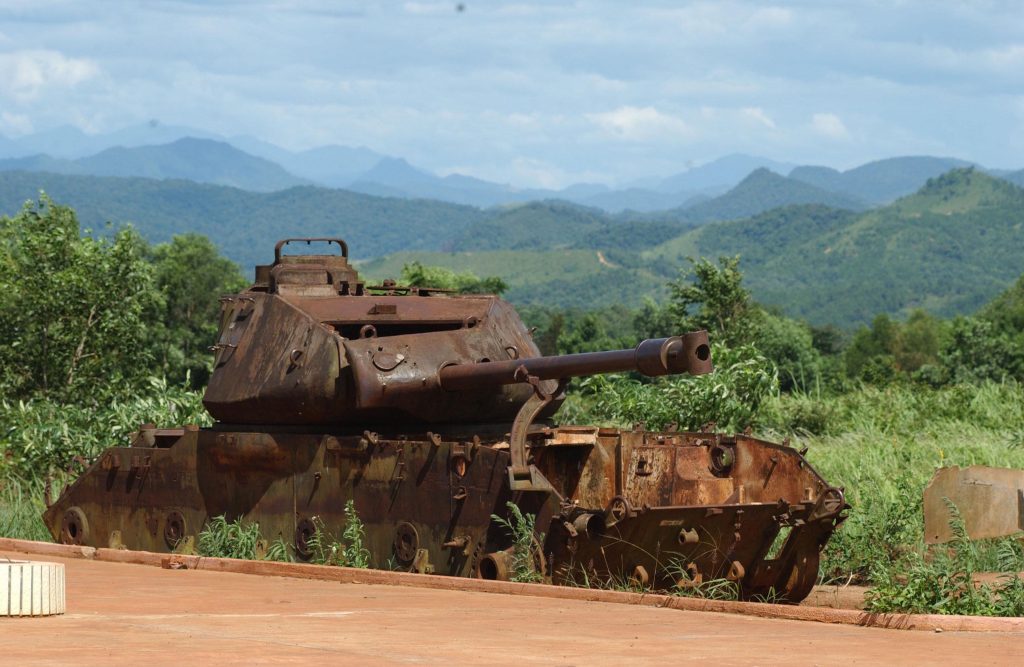
An old tank at Khe Sanh
Seeing the actual sight of all this death and killing was quite an emotional experience for me. It was a poignant reminder of just how totally senseless war really is. And this war in particular. All this killing on both sides was so sad and completely unnecessary.
Having now at least paid our respects to the memory of the perished and having visited he infamous DMZ we continued on up the now “paved” Ho Chi Minh Highway on our way to the next stop.
Khe Sanh To Phong Nha – Recalling the War
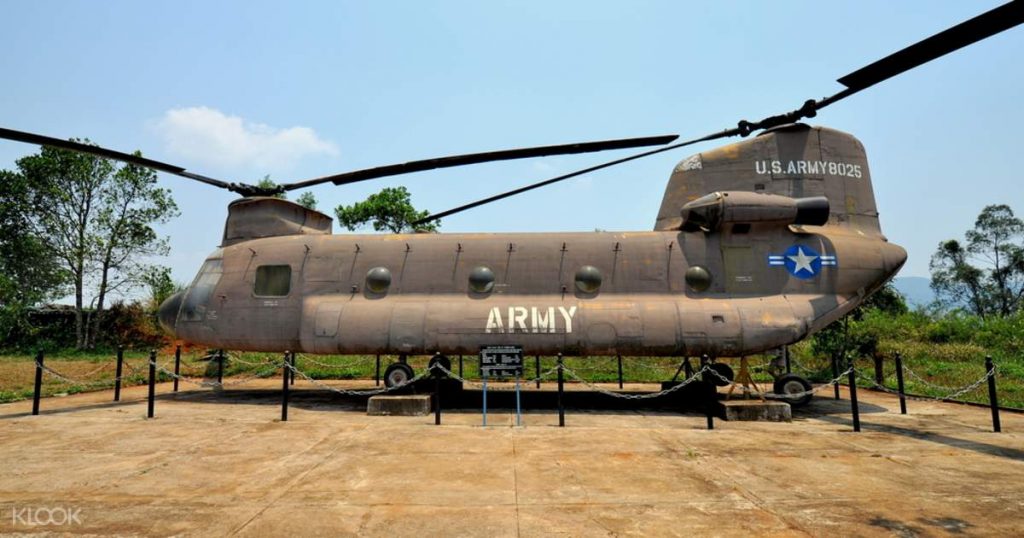
US Army Chinook Helicopter on display at Khe Sanh Combat Base, Quang Tri
Visiting the old Khe Sanh Marine Base and then spending that night in the town of Khe Sanh had a profound emotional effect on me. Being here at the scene of these epic battles from 40 years back was like walking on haloed grounds. At the time of the war I had been an active member of the Marine Corps Reserve and in 1968 I well remember watching the nightly news. Listening to the reports about the infamous 77 day siege that the U.S. Marines had endured at the hands of the tough and persistent North Vietnamese fighters. They had also suffered tremendous casualties during these fiercely fought bloody battles. It was painful watching my fellow Marines dying in this foreign land.
Having just spent several weeks touring the southern half of Vietnam, I had come to realize first hand what a beautiful country Vietnam is and most importantly what a kind and warm people the Vietnamese people really are. The thought of this War that had ravaged this beautiful land and had left so many dead and wounded on both sides left a sickening feeling deep in the pit of my stomach. What the hell were those self aggrandizing American politicians thinking when they pushed the mostly uninformed American citizens into a guerrilla war on this foreign soil that few of us Americans had ever even heard of. Patriotism in those days meant blindly following a U.S. government that really had little knowledge of what they were doing or who they were fighting or the horror that would follow their decision and where they were leading our unassuming country.
What a huge mistake, by both sides, that this war had been! The ghosts of those all those who had died here all those years ago left me deeply saddened.
Riding up the Ho Chi Minh Trails
The 250km ride between Khe Sanh and the city of Phong Nha is considered by many to be the most scenic road of all roads in Vietnam. The trip to Phong Nha is long and takes about eight hours of riding and required that we packed an extra quart of petrol as there were no filling stations on the way.
Soon after leaving Khe Sanh the highway climbs high and cuts deep into the mountains. Mind blowing views provided by huge ascents and descents are repeated over and over again is what awaits the riders who travel this incredible route. Deep valleys are crossed by long curving bridges towering over the forest floors below. We were constantly tempted to stop to take pictures every few minutes but we had to keep moving if we were to beat the fast approaching darkness.
We encountered countless twists and turns interrupted by open straightaways. Our small 110-CC motorbike’s engines demanded our best driving skills in order to hit the correct gears as we drove through corners and hill climbs as we attempted to maximize our speed—it was challenging but at the same time it was great fun.
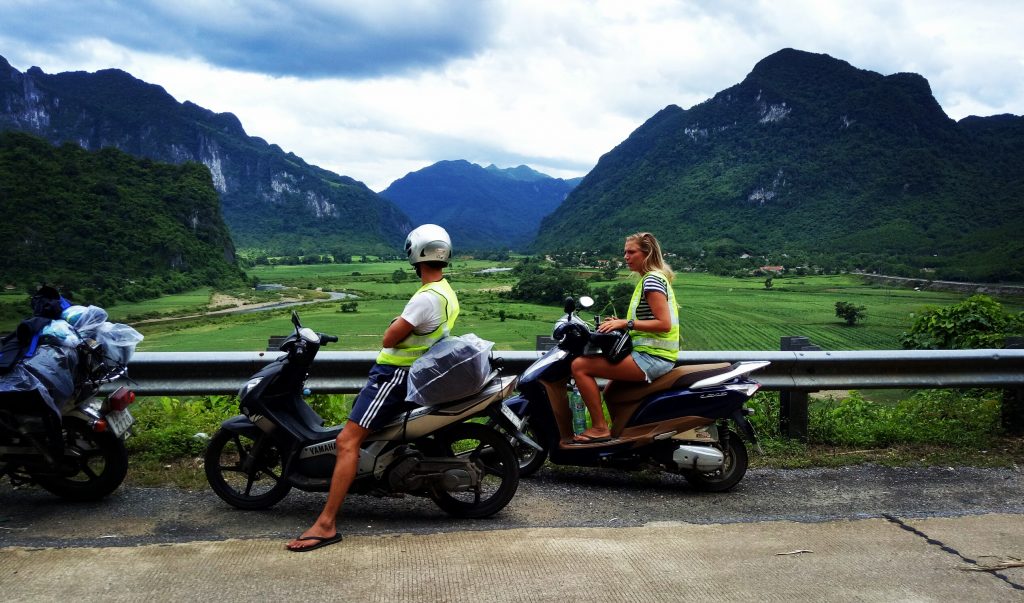
Beautiful landscape near Phong Nha
As Phong Nha became closer the Ho Chi Minh Road turned into long open straight stretches that cross through farmlands as it mirrors the river’s path. The visual build-up to the gem that is Phong Nha National Park became visually more apparent as the landscape changed and we got closer. Soon we encountered Western Style churches along the banks of the beautiful turquoise lake signaling the approaching edge of town.
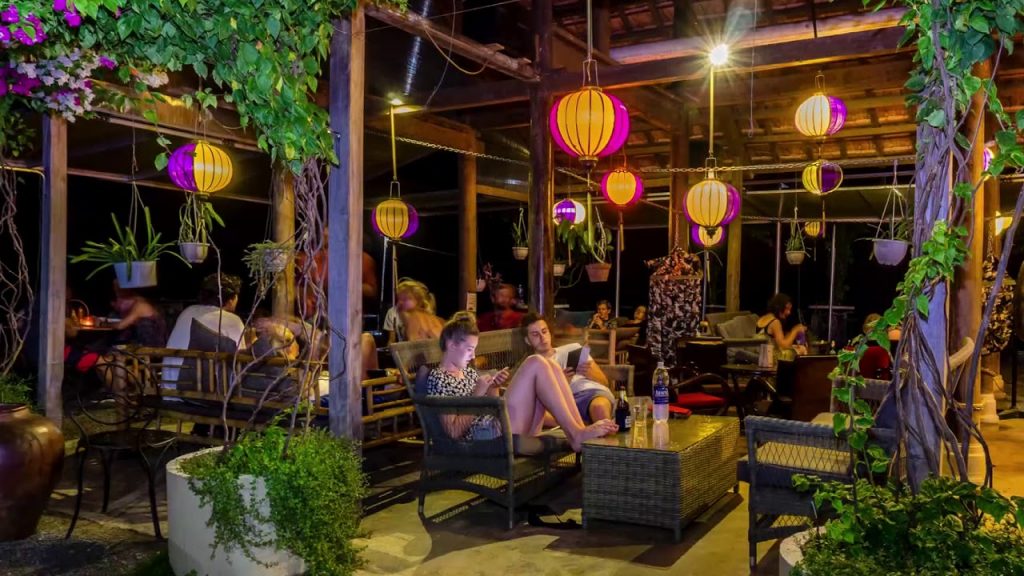
Outdoor of Phong Nha Farmstay
We rode directly to the Phong Nha Farmstay when we arrived in Phong Nha around 6 pm. It had been recommended to us by fellow travelers back in Hue where we made our reservations. We immediately knew this had been a good choice as the beauty and ambiance of the property was readily apparent. As it turns out the Farmstay was a perfect place to experience the Vietnamese countryside and it was located near the cave which we would visit the next day. The beds were comfortable and the room was clean and cute and at the end of our three night stay I wasn’t quite ready to leave.
When returning from hiking around the national park and touring the magnificent Phong Nha cave the Farmstay offered us a welcomed home in which to relax and rest. We sat by the swimming pool and enjoyed a couple of beers while we watched the stunning sunsets while over viewing the rice fields as the ducks and Buffaloes returned home for the night. It was a wonderful calming experience.
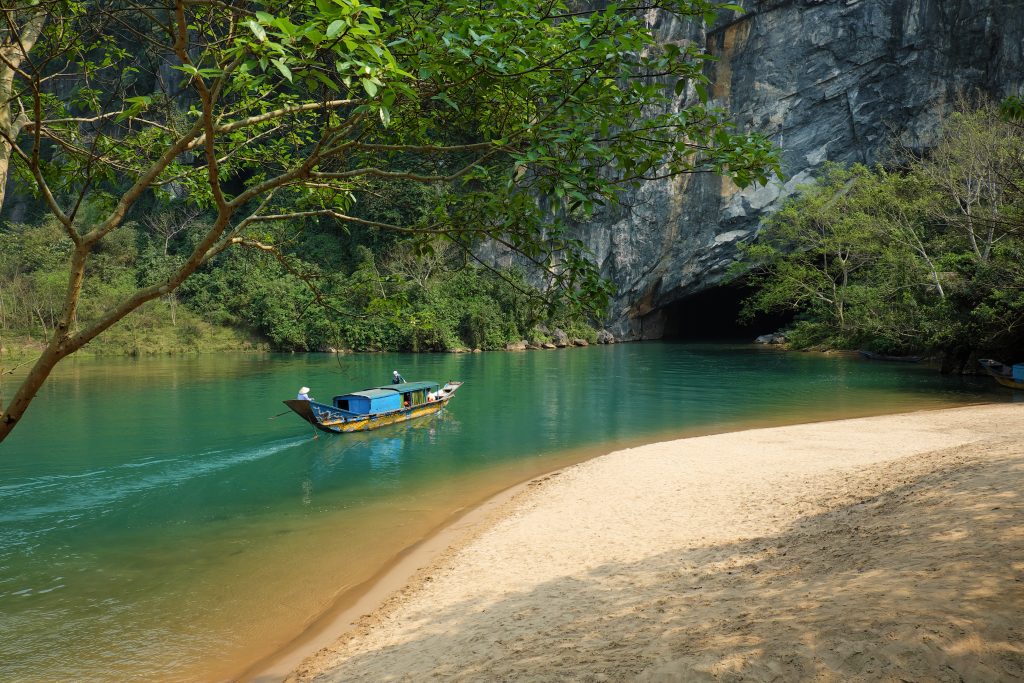
The Entrance of Phong Nha
The Phong Nha-Ke Bang National Park and its many caves deserved the reputation for unmatched beauty. One which we had been hearing about from many sources. The forests are spectacular but they are paled in comparison to the splendor of the caves for which the park is so famous.
The water entrance to The Phong Nha Cave is considered one of the most beautiful cave entrances anywhere in the world. It is the longest wet cave in the world and has a large subterranean river system which runs through the entire cave. We entered the cave on a 30 minute boat ride up the Son River, which is the only way that tourists are permitted to enter. It was amazing. The cave’s lighting system is known as the Twilight Zone and it illuminates the cave’s first 1.2kms in a truly magical way that is so beautiful that words cannot describe. We took our time, about 2 hours, walking around and taking it all in, just admiring the magnificent splendor of nature’s stalagmites and stalactites formations.
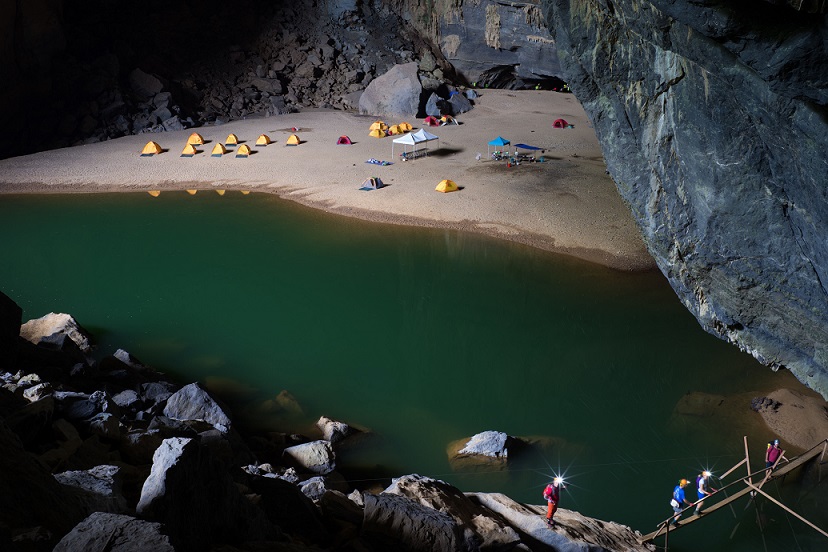
Hang En (Swallow cave) – the entrance to go to Son Doong Cave
The Phong Nha-Khe Bang National Park is also the home of the world’s largest cave, Son Doong Cave, only recently opened in 2013 to a limit of 500 touring visitors a year. Amazingly this giant cave has a big enough mouth for a jumbo jet to land. It is 9km long, 200 meters high and 150 meters wide.
The tour, run by a company named Oxalis, charges $3000 per person and is booked far in advance. And it’s a five day trip through the jungle just to get there. No we didn’t visit this cave.
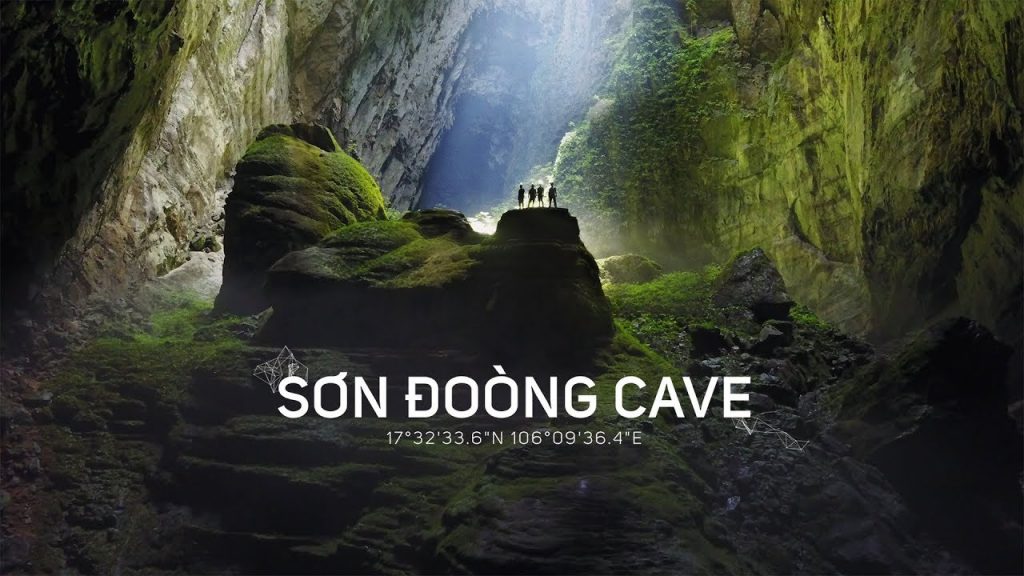
A view of Son Doong cave
Having spent a full day exploring The Phong Nha Cave we decided to spend our second full day exploring the town of Phong Nha and hiking some local trails in the park’s beautiful surrounding forest. After our third night of good sleep we were more than ready to resume our journey north, so after a great Farmstay breakfast we bid farewell to the very friendly and efficient staff and were once again headed up the Ho Chi Minh Highway.
North towards Ninh Binh
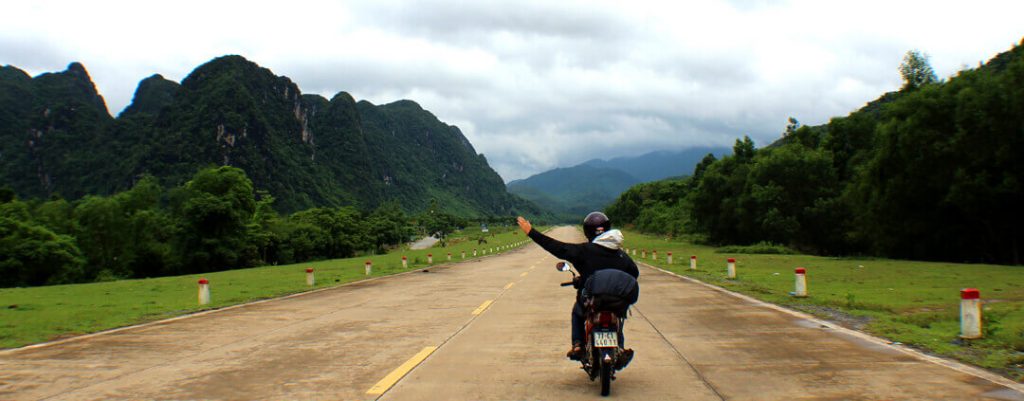
Phong Nha to Pho Chau town
We had read and been told that the Ho Chi Minh Road from Khe Sanh to Phong Nha was the most scenic long road in all of Asia. Having just traveled this route we agreed. Now we were rested and eager to see what lay ahead. The next 100km did not disappoint.
The Ho Chi Minh Road travels along the mountain spine of Vietnam known as the Truong Son Range. Most of its length is comprised of a quiet easily assessable and well-constructed two lane highway with comparatively little traffic.
In today’s journey we planned to make it to Pho Chau town (Ha Tinh province) about 180km northward up the HCMR. On our way out of town we looked back to see an amazing view of the river and mountains which actually now seemed better from afar than it had close up.
The next 100km stretch of road continued on much like the road before—beautiful and engaging. The landscape featured jagged, jungle clad forests reaching for the horizon’s majestic mountains. The scenery surrounding the road was mostly comprised of a beautiful landscape climbing above the dense jungle canopy, clear, fast moving rivers and beautiful valleys cutting through the soft limestone mountains. Small villages and hamlets dotted the road where the local people would come out waving and shouting, displaying friendly greetings as we sped by.
We stopped several times, tempted by the splendor of the views before us. We were provided easy access to these views by the small paved side roads which allowed us to randomly visit these incredible picturesque views, to numerous to count. While we wanted to maintain our schedule, the temptation to stop was too great—after all we reasoned, we would only pass this way this once.
As we traveled along the road, on our way towards Pho Chau, the settlements grew bigger and concrete houses replaced the grass and wooden huts. Civilization it seemed, was fast approaching as the forests gave way to the sprawling greens of agricultural fields primarily comprised of rice.
We stopped in Huong Khe (Ha Tinh Province) for lunch before resuming our journey to Pho Chau town (Ha Tinh province). The land we passed through was reminiscent of another time during the 1800’s, a time when people used Buffaloes instead of cars and motorcycles and bamboo instead of plastic. The seductive lush hills of Vu Quang National Park but the road where it is widely believed that rare wild Indochinese tigers still roam deep inside the forest. It is here that in the 1880’s revolutionary patriot Phan Dinh Phung fled, to muster a resistance force of local warriors to battle the French.
The ride to Pho Chau was comparatively easy as it was mostly flat and the surrounding landscape was primarily composed of green agricultural fields, primarily fields of yet to be harvested rice. It was becoming dark so we checked in to the recently built Minh Tu Hotel on the outskirts of Pho Chau. What a pleasant surprise this hotel turned out to be. The room was good size and the bed was comfortable and well-appointed and reasonably priced at 250,000 VND. The swimming pool was impressive and inviting and we immediately took advantage of the cooling waters. It looked out on the nearby river offering us an excellent view as we enjoyed the ambiance while sipping a couple of cold refreshing beers.
Pho Chau, we later discovered, is noted for being the first Vietnamese truck stop for trucks on the route used to transport dogs from Thailand on their way through Laos destined for the dining tables of many restaurants in Hanoi. Not sounding to appetizing for our tastes.
Here, geographically, the HCMR is considered to be in the neck of the country. The road passes through the Ha Tinh and Nghe An Provinces consisting of forests, field farming and flowing rivers. We enjoyed the riding here because it was scenic, quick and easy, helping us to cover a lot of ground quickly.
When we first left the Minh Tu Hotel the road passed by a Vinamilk dairy farm. One of the many Vinamilk farms making up a part of one of Vietnam’s biggest companies and the largest producer of milk and yogurt in the country. Wending its way through a rolling landscape covered with rows of sweet corn, cassava, lemongrass and giant eucalyptus trees the countryside was simply beautiful.
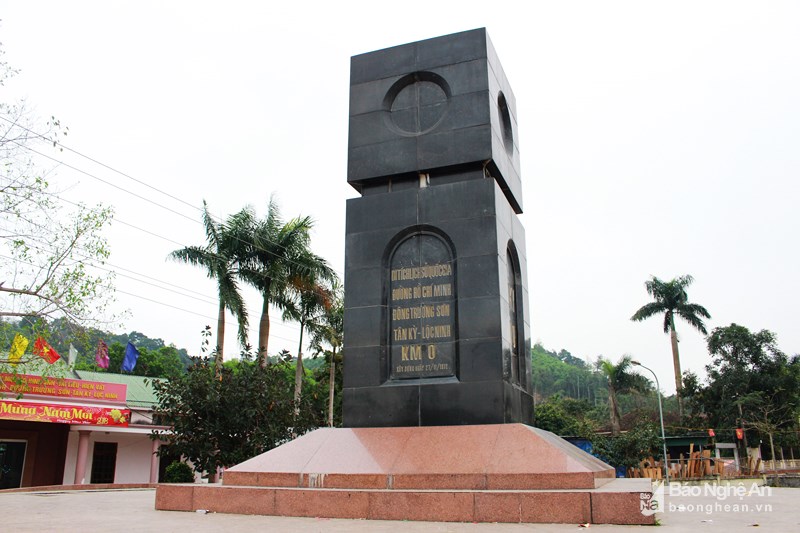
Km 0 of the Ho Chi Minh trail
Soon the road entered Nghe An, the largest province in Vietnam. Known as ‘Nghe An Buffaloes,’ the people of this province are famous for their resilience and toughness, a product of the local harsh daily weather conditions. It is here that some of Vietnam’s most famous historical names were born. Along the way we passed within a couple of miles of one such name and past residence, Ho Chi Minh’s childhood home.
It seemed like a very long ride across this huge province but the road was in great shape and the weather was dry so with the light traffic we were there in the town of Tan Ky (Ha Tinh province) before we knew it. Here we stopped for lunch across the street from the Ho Chi Minh Trail Museum. Tan Ky is also considered to be the original starting place of the Ho Chi Minh Trail back in the beginning of the war.
After finishing lunch and visiting the small but interesting museum we continued up the road toward the city of Thanh Hoa. On the way we admired the beautiful green hillsides, richly covered with bamboo and we were enthralled by the large distinctive limestone karsts appearing on the horizon. Later that afternoon we checked into the very pleasant Lan Anh Hotel in Thanh Hoa. This was our final stop before pushing on the next day to the much anticipated Ninh Binh. We were looking forward to Ninh Binh, this favorite destination, known to be a land equal in many ways to the famous Halong Bay. We went to bed early as we could hardly wait to see Ninh Binh.
Ninh Binh
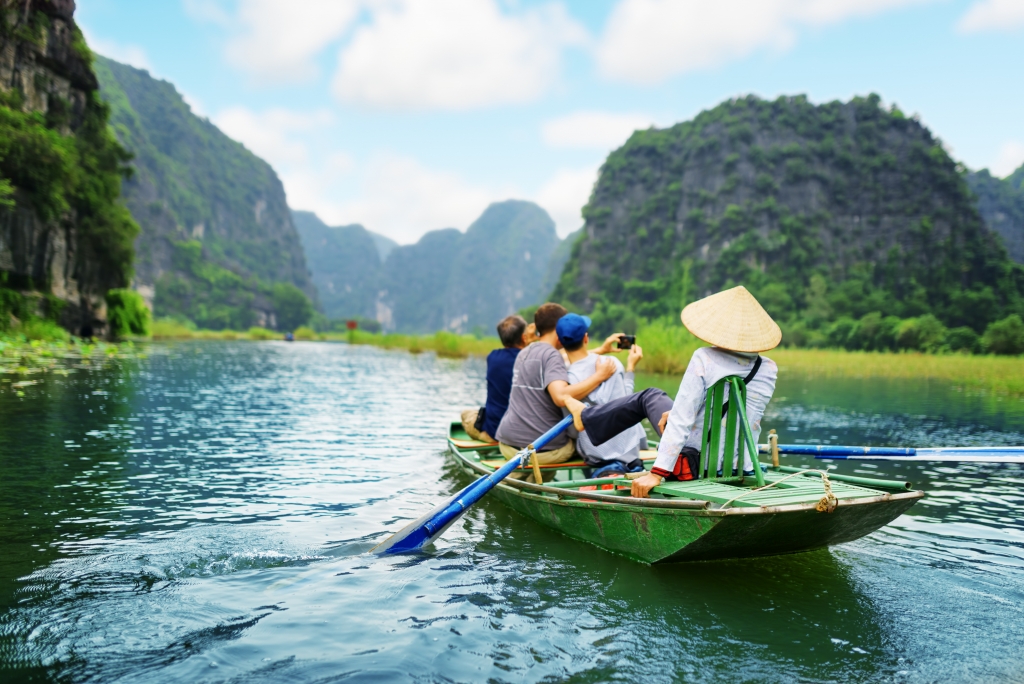
Tourists traveling in boat along the Ngo Dong River and taking picture of the Tam Coc, Ninh Binh, Vietnam.
Ninh Binh is a special place where the scenery is simply spectacular and the access from Hanoi is an easy trip to a rural and and authentic side of Vietnam. Ninh Binh located in the Red River delta, boasts one of the most majestic and impressive landscapes anywhere in Southeast Asia. The life style in the entire province is low key with the population moving at a very slow and easy pace, due in part to the incomparable beauty of the surrounding landscape.
The good news is that it is still largely undiscovered by the massive hordes of tourists that are constantly swarming popular Vietnamese tourist sites such as Halong Bay. Because it is relatively new as a prime tourist attraction the on line information is still scarce and confusing. Accordingly this is a destination that is perfect for a traveler like me who likes self-discovery and does not use the tours which are often soulless and rushed.
Did I think it was worth the extra effort to travel out of my way from Thanh Hoa to Ninh Binh instead of going straight to Hanoi? Absolutely! I found that it realistically takes 2-3days to explore the various sites which comprise this magnificent area properly. Located 100km south of Hanoi it is an easy visit for anyone traveling from there. A primary feature of the landscape and immediately evident are the hundreds of Karst limestone cliffs emerging from the ground and ubiquitous rice fields. Appearing similar to the cliffs of Halong Bay, but sprouting from land and not water, this accounts for its nickname “Halong Bay in land”.
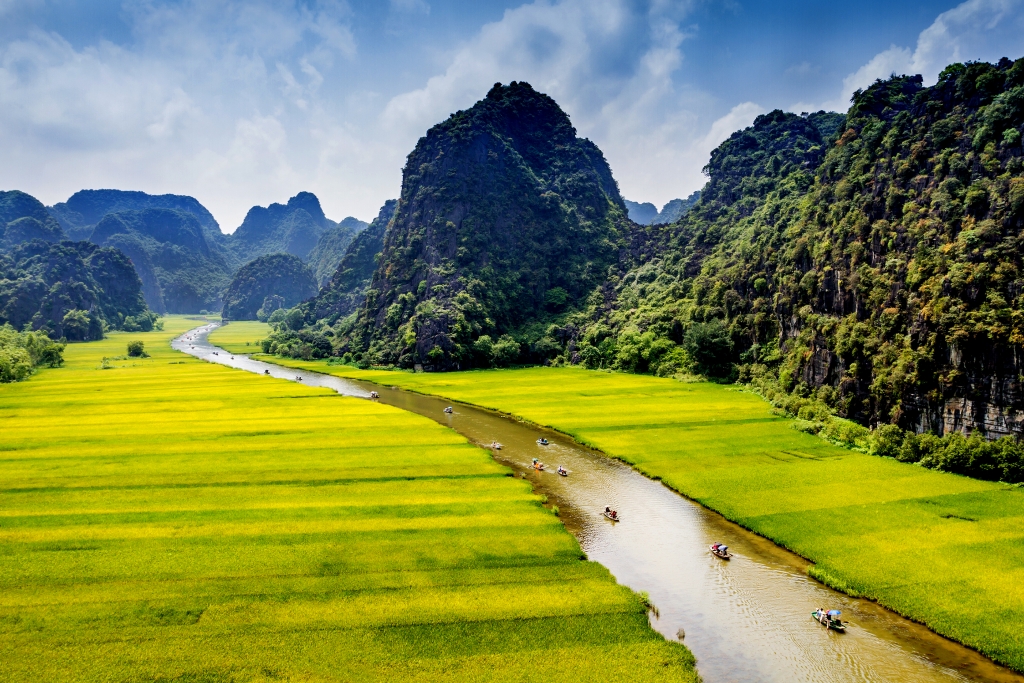
Scenery of rice fields with a river inside (Ngo Dong river) in Ninh Binh
The pace of activity in the Ninh Binh area is the perfect example of the Vietnamese laid back living experience which we had hoped to find. By staying in a “home stay” we found an opportunity to peek into how the rural way of life in Vietnam really is. Sleeping on the mosquito net covered mattress and sitting before a home cooked Vietnamese meal we got a real taste of authentic local living. It all added up to an experience right out of a story book of ancient Vietnamese travel.
We were there in November which was good for weather but not so good for photos as the recently harvested rice fields were yellow and brown instead of the brilliant green you see in the rice field pictures in travel brochures. The weather however was great with no rain and with day time temperatures around 20 degrees.
As there is a lot of space between each of the main Ninh Binh attractions having our motorbikes was a big blessing. We covered about 30kms each day visiting the various sites and having our own bikes made it easy. One of my favorite things to do was to ride through the rice fields with reckless abandon, which was a ton of fun for me, as we rode between the various sites along the authentic country lanes.
All the major attractions, for which the area is famous, are found outside the rather dull and boring city of Ninh Binh. This was a good reason for us to stay either in Trang An or in Tam Coc. We arrived in the afternoon and found an excellent home stay in Trang An. This allowed us to get an early start the next morning with the small boats before the buses from Hanoi arrived. All the major attractions are found in the four different areas of Trang An, Tam Coc, Van Long and Cuc Phuong.
Our early morning boat ride in Trang An turned out to be my second favorite activity of all. Arriving early in the morning we managed to get a boat to ourselves instead of the normal four passengers. It was rowed by a skilled middle aged Vietnamese lady who was friendly and even spoke a little English. She rowed us peacefully on the river through the caves and lakes and along the rice fields past temples and the Karst limestone cliffs. The scenery in the early morning was mesmerizing. Early in the morning or later in the afternoon is the best time to go for your boat ride as the day trippers in the large busses are usually not around having not yet arrived or departed.
We divided not to go on the more popular Tam Coc boat ride because it was kind of a duplication from yesterday’s and also known as a minor scam spot. Instead we rode our bikes along the shore following the same route as the boat’s on shore where we could and did our own Tam Coc boat tour on the land.
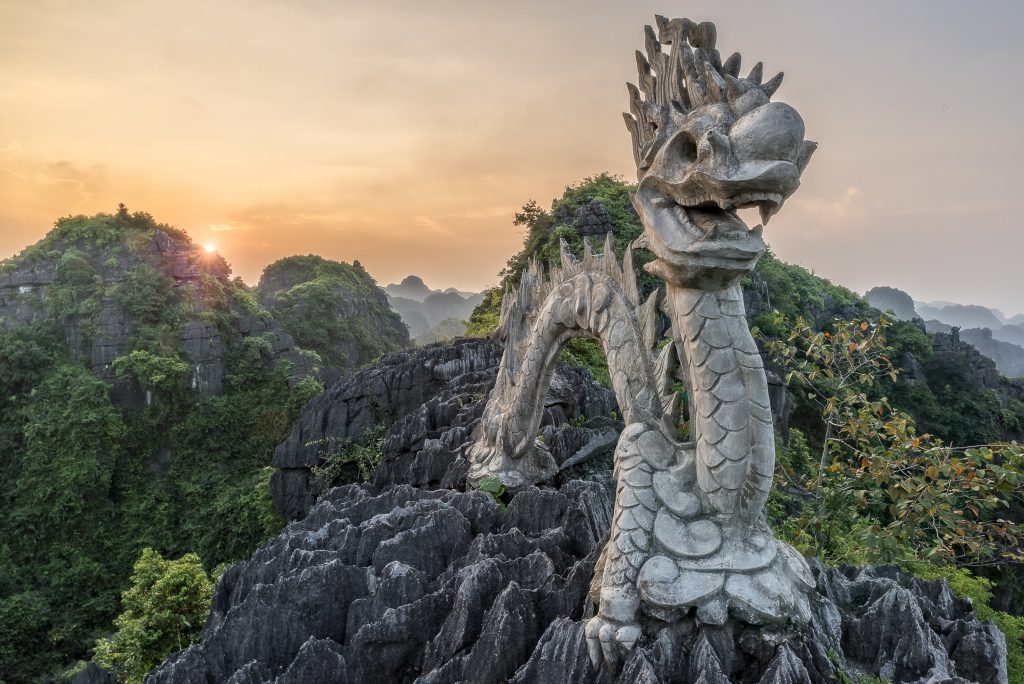
Peak of Dragon Mountain in Tam Coc – Ninh Binh
My favorite attraction was the Hang Mua Peak and Lying Dragon, located at the peak, also called Hang Mua Cave. The dragon sits at the top of a 500 step flight of stairs. The stairs were challenging but the view of Tam Coc from this elevation was simply stunning and well worth the climb. This spectacular view takes in all the limestone cliffs and rice fields below. This view is thought by many to be the best in all of Southeast Asia. A view, while similar, is one superior to even Halong Bay.
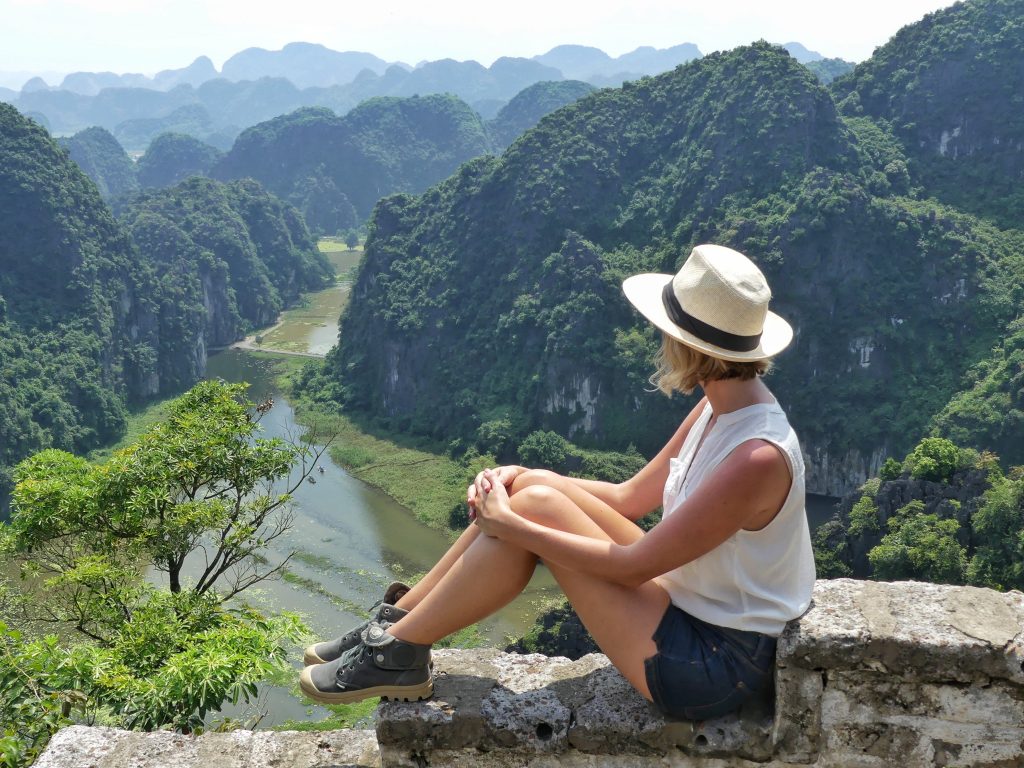
A tourist enjoy the view from Mua Cave in Ninh Binh
Ninh Binh, I felt was by far the most visually underrated stop of our entire trip. It had been a last minute decision to detour off our original itinerary and it was a good one. The Ninh Binh area boasts a breathtaking, sometimes surreal, landscape of tall Karst limestone scenery which is truly a natural wonder. It felt as though we had been physically transformed permanently into a National Geographic documentary. The best thing however about Ninh Binh, I felt, is not just the beautiful landscape we experienced on the outside but rather the beauty from inside: “the authenticity” of the people and the whole place in general. It was the peace and quiet that we had found that represented the real rural Vietnam and we loved it.
The Mai Chau Valley
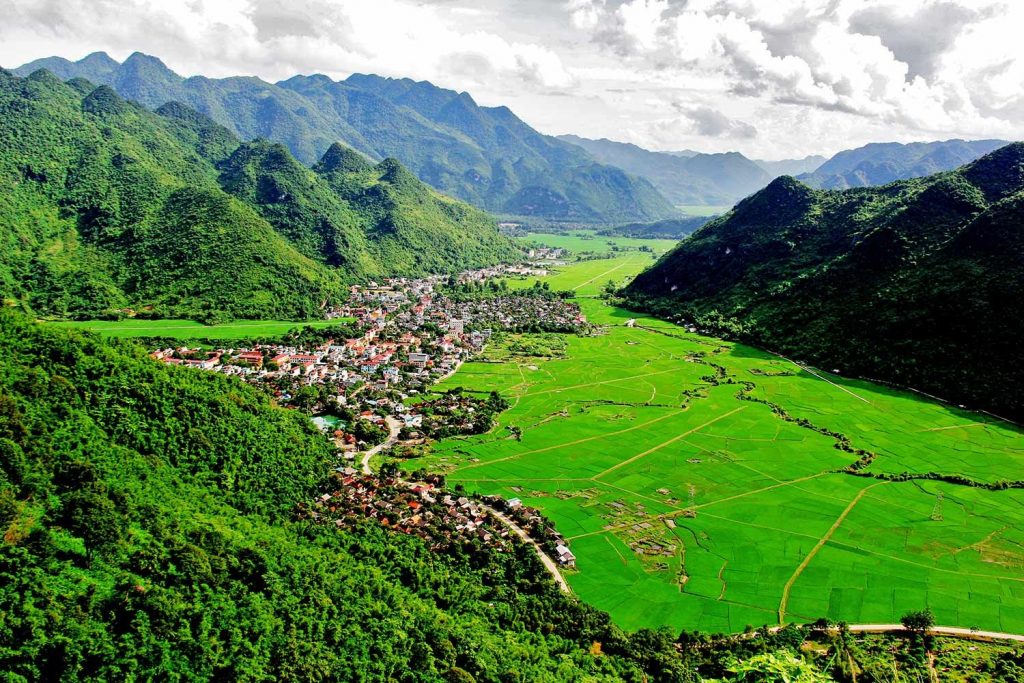
Mai Chau Valley, Hoa Binh Province, Vietnam
While in Ninh Binh we were encouraged by several travelers to make our next stop the majestic Mai Chau valley in the Hoa Binh Province. You won’t be sorry they promised. (And boy were they correct). As it was relatively close and only a few hours ride West, we decided to take their advice and check out this highly recommended tourist destination.
To get there we had to travel over the steep Thung Khe Pass (Đèo Thung Khe) and make our way down winding mountain roads which were covered by a sea of white puffy clouds—it was mindful of passing from heaven to earth. We enjoyed a roadside lunch from the top of the pass and marveled at the stunning views where the valley appeared most beautiful thanks to the evergreen trees, rice fields and the many stilt houses scattered below. It was still November and the weather was great so the view was unbelievable.
The Mai Chau Valley area is yet again another great example of Vietnam’s seemingly never ending and amazing natural beauty and picturesque landscape. As we approached the valley below the surrounding hills transformed into the familiar open rice fields, karst mountain cliffs and a valley filled with quaint wooden and bamboo villages.
Located in an idyllic setting only 4 hours away and about 150kms east of Hanoi, the Mai Chau Valley is an extremely popular spot for which, the Hanoi residents swarm to enjoy a weekend or a few days get away of rest and relaxation. Accordingly, we wanted to visit mid-week to avoid these Hanoi crowds and experience the daily peace and quiet on our own.
We choose another home stay in order to once again experience the peaceful ambiance of local rural Vietnamese daily life. The houses here were built on stilts lifting them 5-6 feet off the ground. Being raised on stilts not only keeps the houses dry during rain storms but also improves ventilation and discourages various insects and other pests. Most still use thatch roofs common to the traditional Thai houses of the distant past rather than the modern corrugated iron sheets which are seen all over Vietnam and are much hotter and less attractive.
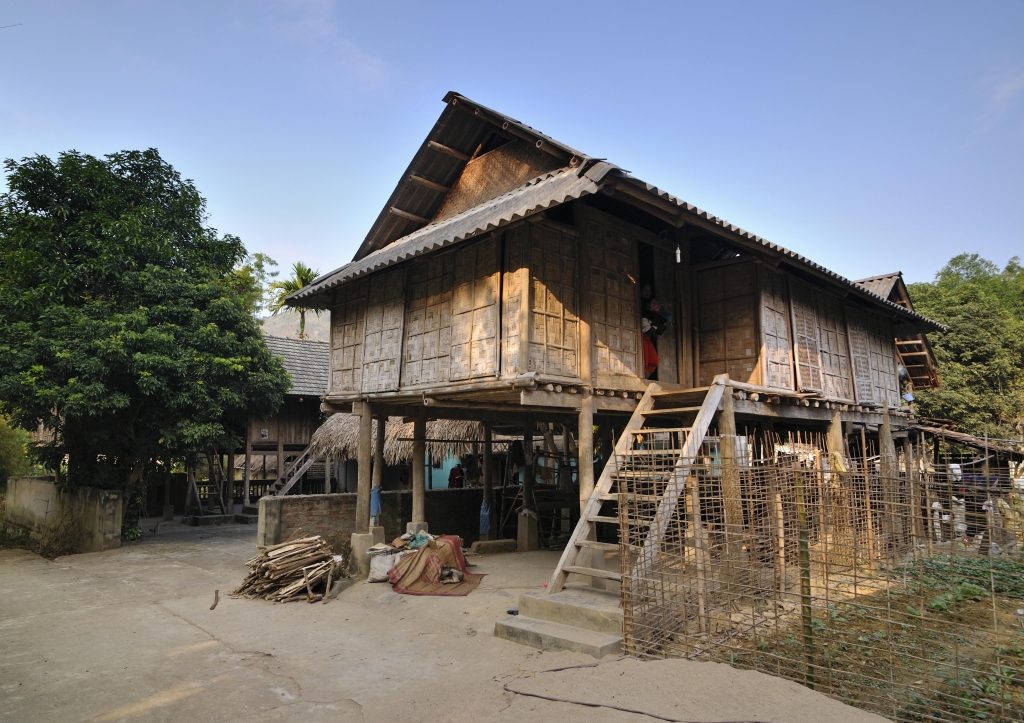
A view of a village where ethnic minorities live in Mai Chau, Vietnam
We stayed in a village named Lac (Bản Lác) with a white Thai family whose ancestors migrated to the valley centuries ago. Like in Ninh Binh we once again we used mattresses resting on squeaky sodden floors and surrounded by the welcomed mosquito nets. We slept peacefully and pleasantly and awoke to the crowing of roosters and the gurgling of irrigation streams with a background of small birds singing their joyous morning songs. At night we joined the family for a delicious ethnic Thai meal and some local beer which helped us sleep so well. This was our splendid setting where we partook in the local culture by hiking and riding bikes to other local villages and soaked in the beautiful scenery around this splendid and serene valley. After a couple of days of relaxation here in the Mai Chau Valley we had practically forgotten what century we were actually in.
On our way to the Mai Chau Valley we had stopped to visit the Hoa Binh Dam which is the largest hydroelectric plant in Vietnam. This impressive dam backs up a lake that contains many square miles of water which produces most of the electrical power to the northern part of Vietnam. Watching the huge amount of water powerfully cascade down the dam’s chutes was an exciting and unique experience. Just sitting on the side of the causeway with all that water rushing past us was very impressive.
We visited the famous Chieu Cave (Hang Chiều in Vietnamese) later that afternoon. The visit required climbing up the hillside on a staggering 1200 hand carved steps to reach the caves entrance. It was worth every step. Chieu is a one of-a-kind amazing cave experience filled with stone sculpture like structures that remind you of some other time and space. Chieu is a local name meaning “afternoon” and the cave is called this because on a clear day in the afternoon the sun’s rays fill it with sparkling jewels of reflective light. Extremely beautiful to the eye.
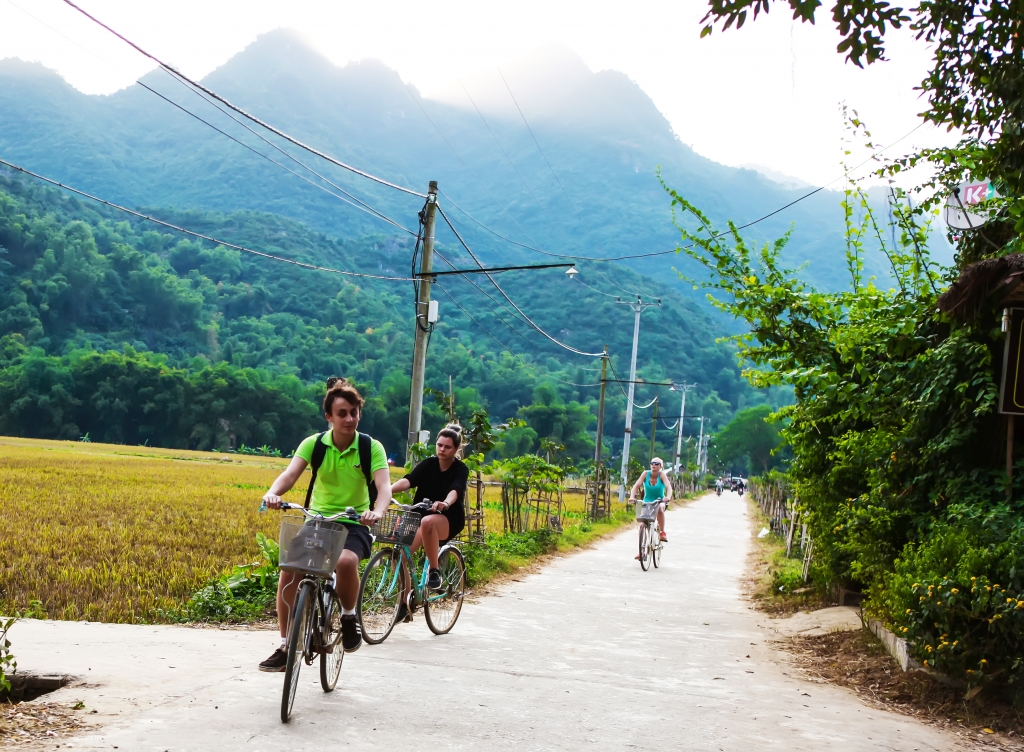
Cycling around the Ban Lac, Mai Chau, Hoa Binh
Besides the stunning natural beauty of the valley is best known for its concentration of ethnic minorities with the Thai people being by far the largest group. The Thais still keep their rich ethnic traditions including the palm leaf roofs and bamboo-stat floors.
In keeping with tradition all of the village houses contain looms for weaving the colorful brocade fabrics. The Thai, with their traditional cultures, have established famous community spots in the three villages of the Pom Coong Village, along with Lac Village where we stayed and the Van Village.
Thais are most famous for specializing in weaving traditional brocade silk fabrics with rich colors made from natural dies and raised patterns. The Thai women’s typical daily wear makes heavy use of brocades as demonstrated in the tight-fitting waist band worn when they perform manual labor.
The women weave the silk brocades from scratch. They begin with harvesting silk worm cocoons, reeling the silk from the cocoons and then dying them the natural colors. When finished the brightly colored brocades, for which they are famous, are sold in the local markets.
After we had spent these two nights in Mai Chau Heaven and it was time to move along to our next destination, but it was with a reluctant heart that our departure was about to happen as we really loved this valley.
My Visit to Dien Bien Phu
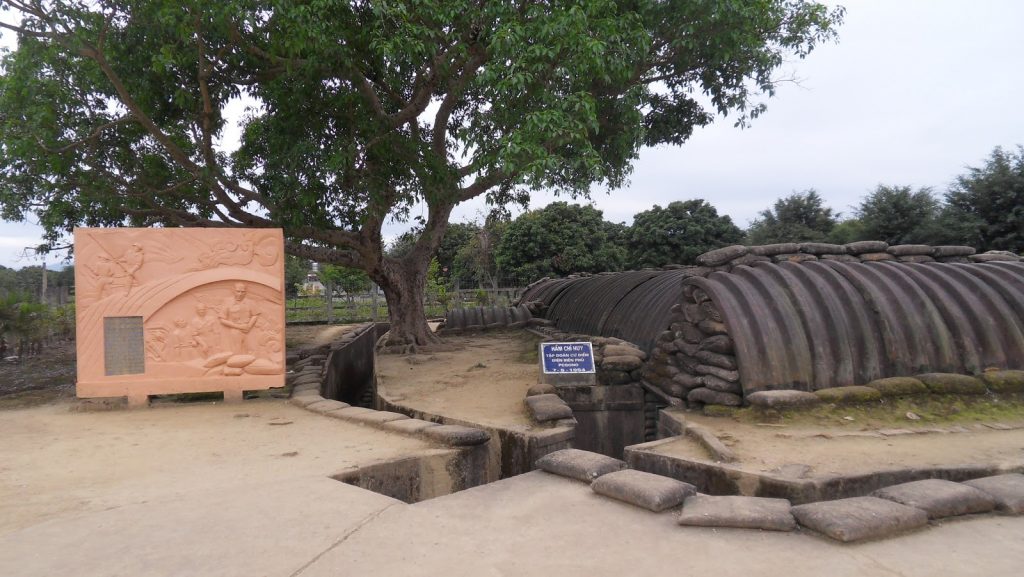
The French Headquarter in Dien Bien Phu
As a former U. S. Marine, I had more than just a passing interest in this historical landmark of the French Indochina War. This defeat of the French forces by the Viet Minh in 1954 had had grave consequences for Americans years later in their war with the North Vietnamese. It was because of this defeat that, at the time, Vietnam was divided in half at the 17th Parallel thereby creating two Vietnams and leading to the American involvement in the 1960s.
The Viet Minh army was led by a brilliant General named Vo Nguyen Giap who was to become a hero similar to Ho Chi Minh. It was his strategic planning that was responsible for their victory over the badly outnumbered French forces during a bloody 56-day siege that ended in May of 1954. More than 6,000 French soldiers were killed, wounded or captured during this infamous loosing-battle. I wanted to see the ground where this epic event had happened.
Since, we were in the Mai Chau Valley, we would never be closer to Dien Bien Phu so we decided to make the effort and take the 8-hour trip to visit this historic sight first hand. We decided to cut the long trip in two and stop at the half way point, the city of Son La. After checking into a pleasant small hotel, The Trade Union, we headed to the most famous tourist attraction in town, the long since abandoned Son La Prison.
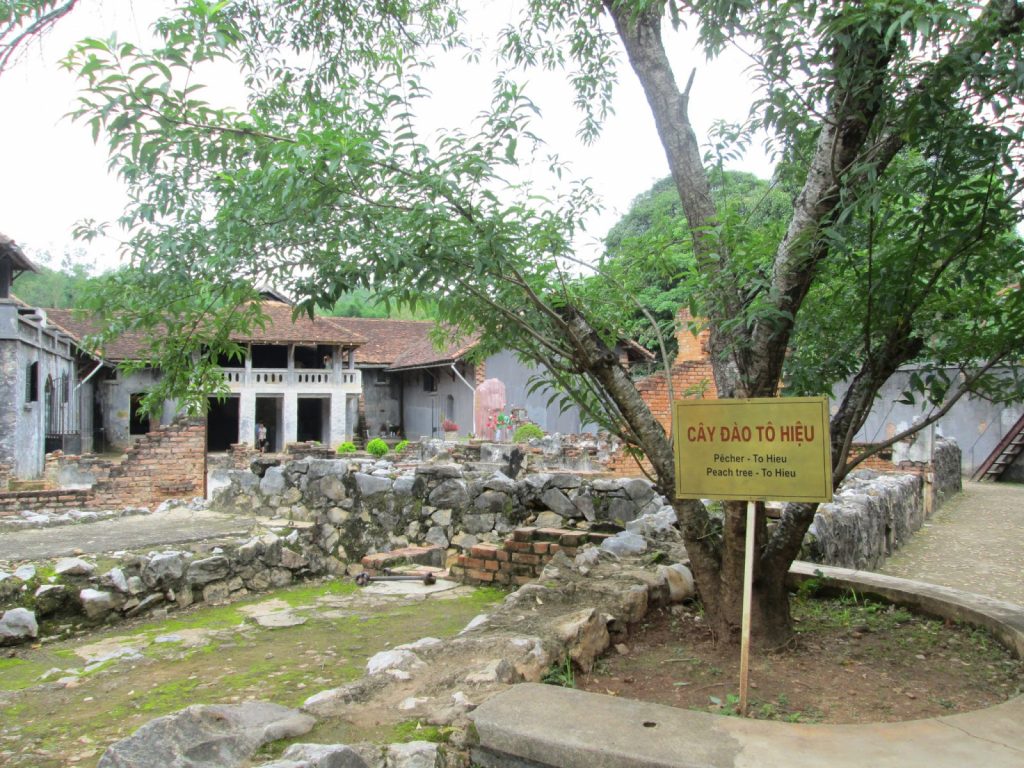
A view at the Museum of Son La Prison
This French prison had been built in 1908. It was expanded in 1930 and again in 1940 to accommodate the ever-increasing prisoner population of political prisoners generated by the Viet Minh liberation movement.
Nicknamed “the grinder”, it was famous for being the cruelest and most miserable prison in Vietnam. Often described as being an “open coffin” just waiting for prisoners to die. Inmates would typically arrive there after a horrific 13 day forced march during which many prisoners would actually died. This was a place where malaria was rampant and the conditions were considered to be worse then even those found in Hanoi’s infamous Hoa Lo Prison.
These miserable conditions created the opposite effect from that which the French had envisioned, in that strong Viet Minh resistance cells mysteriously formed and spread among the prisoners. If these guys weren’t Communists before they went in, they usually were by the time they left.
There is an exhibit of black and white photos along with some old hand and leg irons displayed in what was once a guard house. It’s hard to imagine just how human beings could spend years of their lives in these dank, dark underground chambers. One can only imagine what that must have been like especially during the boiling hot summer months. The idea that the “civilized French” were somehow strangers to cruelty was forever lost on me that day.
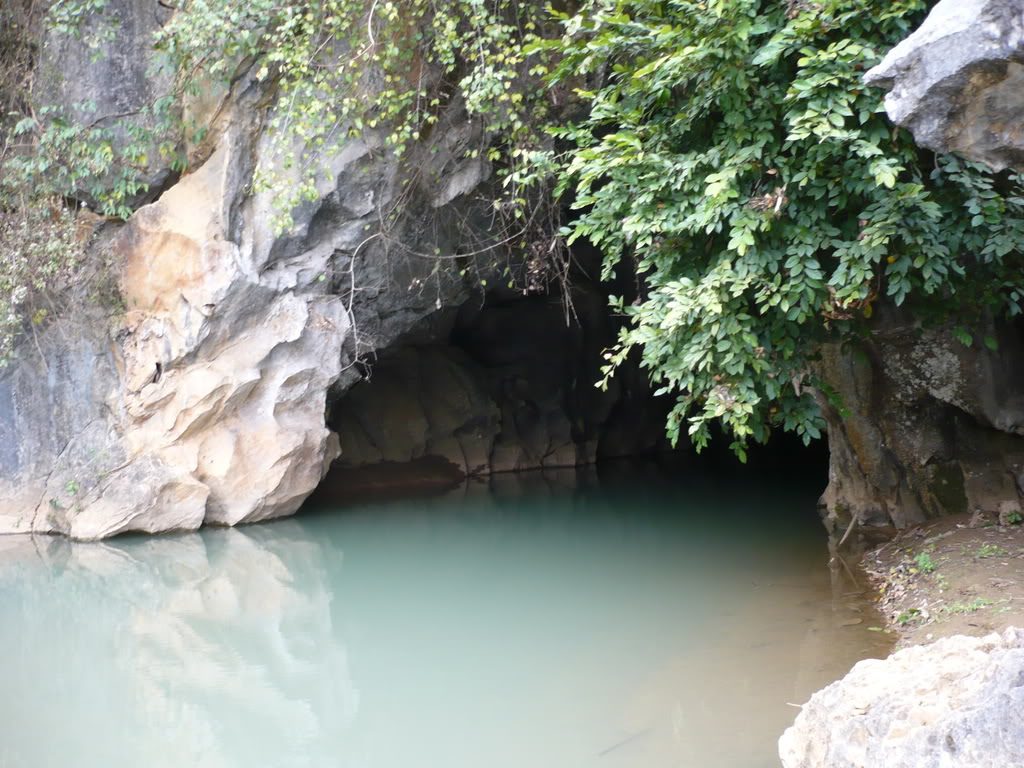
Tham Tet Toong Cave in Son La
The next morning on our way to Dien Bien Pho we stopped at the Tham Tet Toong Cave about 4kms north of town. The relatively small but beautiful cave was an interesting stop. The cave is about 150 meters long and displayed some beautifully well-formed sculpture like stalagmites and stalactites artfully illuminated by the lights which were placed in the cave.
Other than the history of the French war the city of Dien Bien Phu is not much of a tourist attraction except for the historically curious person such as me, as it is one of the most historically relevant sites in modern Vietnam history. This is where the French War Was won by the Viet Minh troops commanded by General Giap, marking the collapse of France’s entire Indochina Empire. “A beautiful place to die” remarked a French historian. And many in fact did die here as evidenced in part by the cemetery blow.
Little remains of the many battles dating back to the spring of 1957. A large statue is the most significant reminder of the bloody battles suffered by the troops on both sides some 64 years ago. The trenches, barbed wire, encampments and battle lines that once crisis-crossed the land have long since given way to development and agriculture. However, a handful of war vestiges have been carefully preserved, enabling visitors to form some idea of what the battles that once raged here must have been like. For most travelers, a visit to A-1 Hill and the small museum will provide all the coverage of the battles that they require. But not for me.
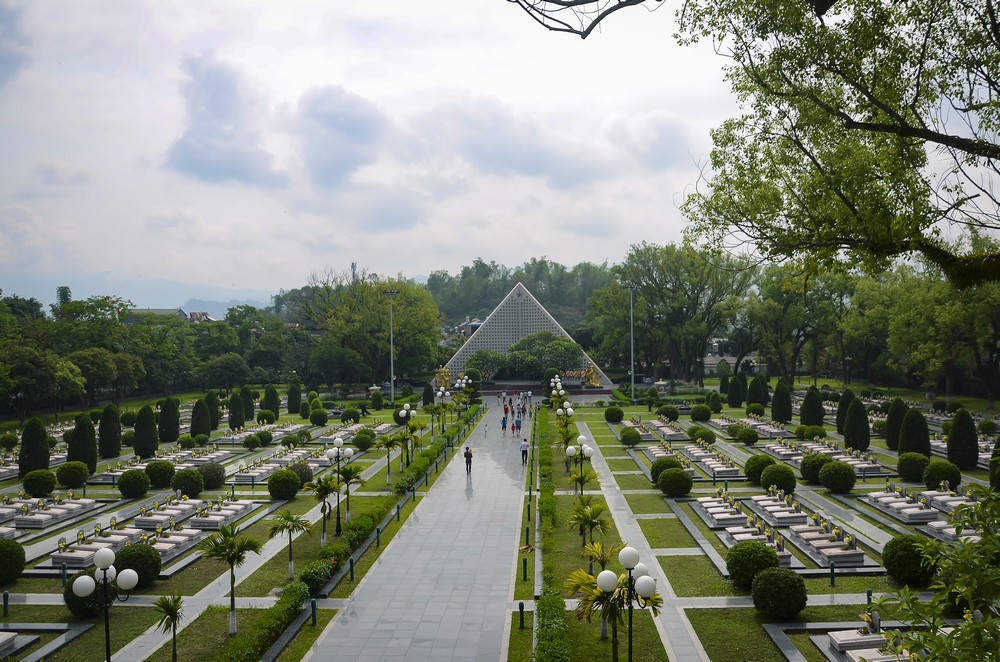
Dien Bien Phu Hill A1 Cemetery
Hill A-1, named Elaine 2 by the French commander Colonel de Castries, is located in the center of the town that now stands where no town stood in 1954. This original bunker is located on the spot that afforded the French soldiers a full view of the entire valley below. It was the key bunker of the seven original French positions and the last one to fall to the attacking Viet Minh warriors. Today the location of Hill A-1 bunker is marked by a French tank which can be viewed by tourists when visiting the bunker. These give the visitors a good idea of what it was like for the French soldiers back in 1954. Just imagining what it must have been like to be one of the few thousand French soldiers facing the onslaught of the over 25,000 Viet Minh charging down the hill was a very sobering thought for me as I stood looking up at Hill A-1.
The bunker Hill A-1 was dynamited from tunnels secretly dug by Vietnamese soldiers as well as by heavy artillery from the hills above. The French lost in part because they had miscalculated the Viet Minh’s ability to encircle them from above with heavy artillery. Something which Giap’s forces had successfully done over an extended period of time by hiding the guns underground and then moving them into position at the appropriate time.
The well-kept, Site And Cemetery down the hill below Hill A-1, is where mostly Viet Minh but some French soldiers as well, lie in their eternal resting place. It is a poignant testament to these past battle’s bloody history which today call out to all the silent observers.
Story to be continued—
